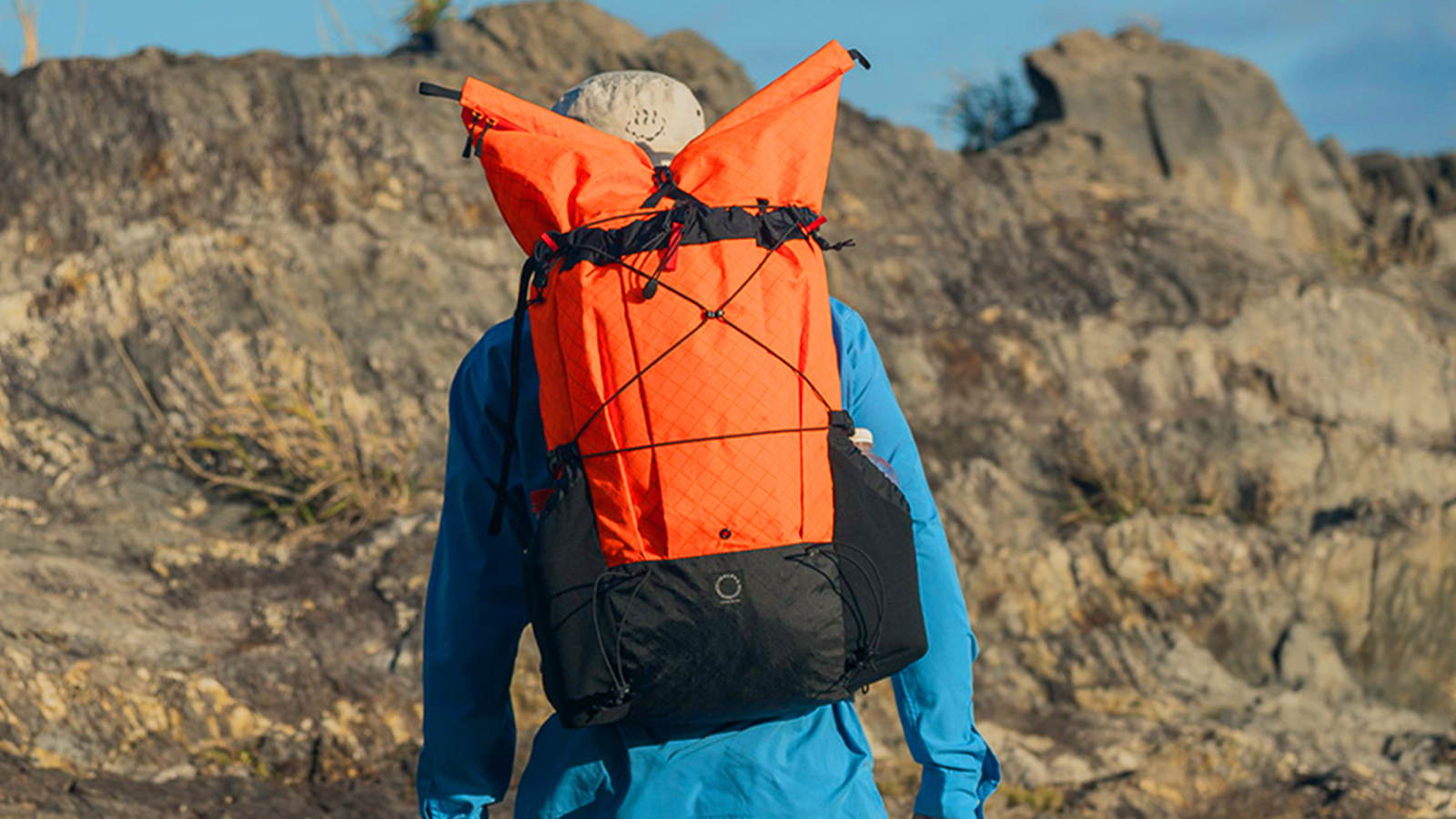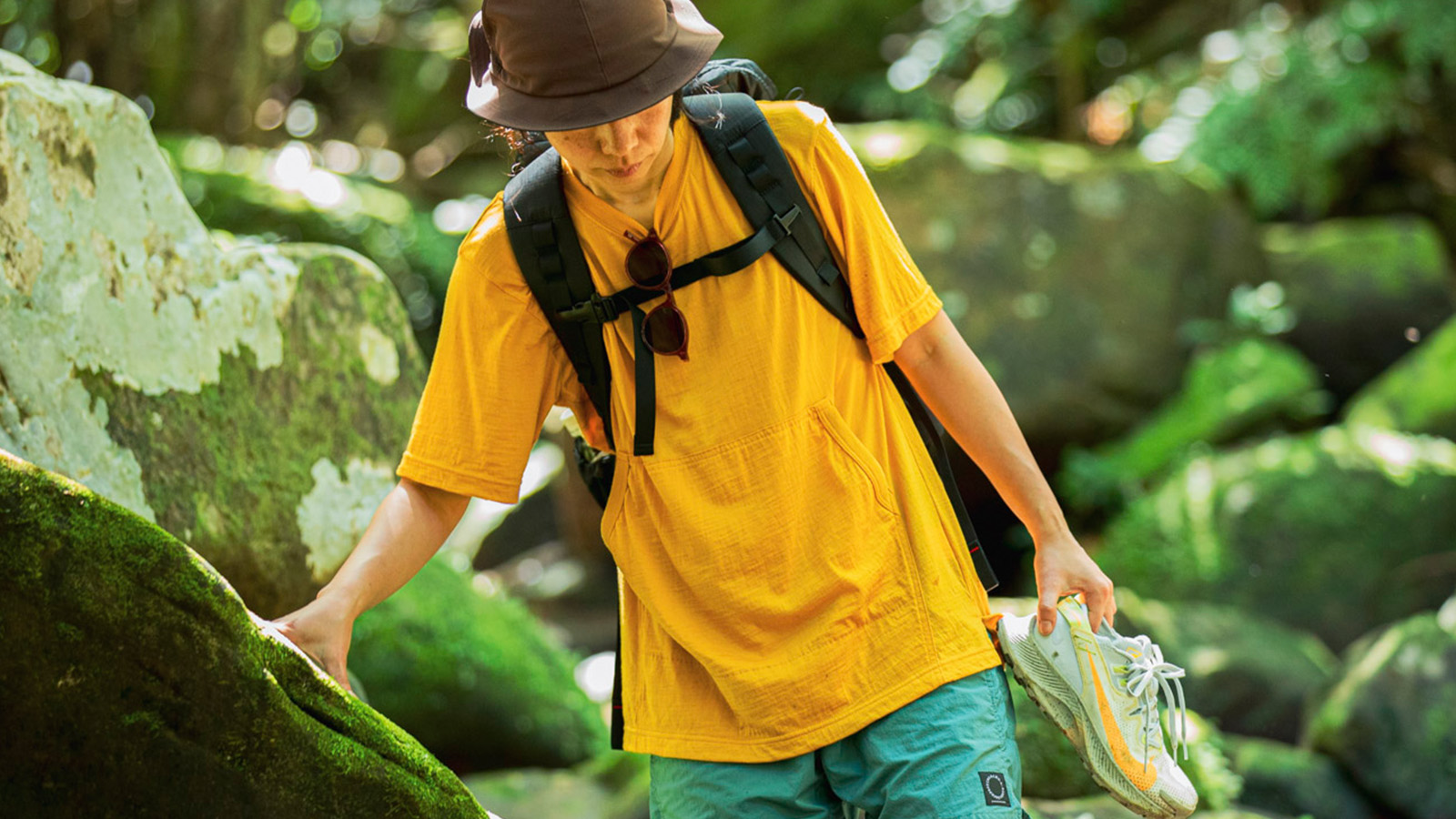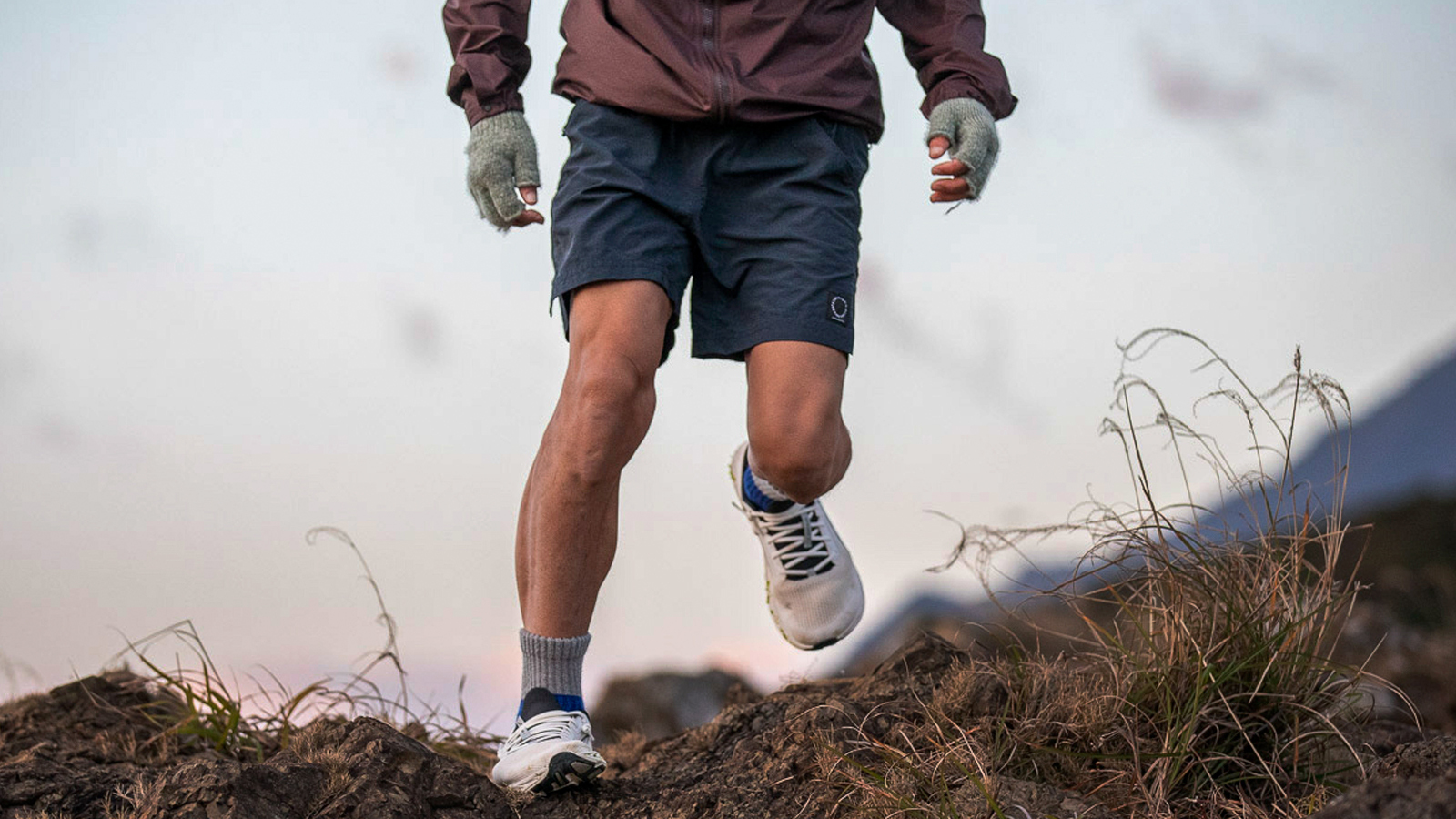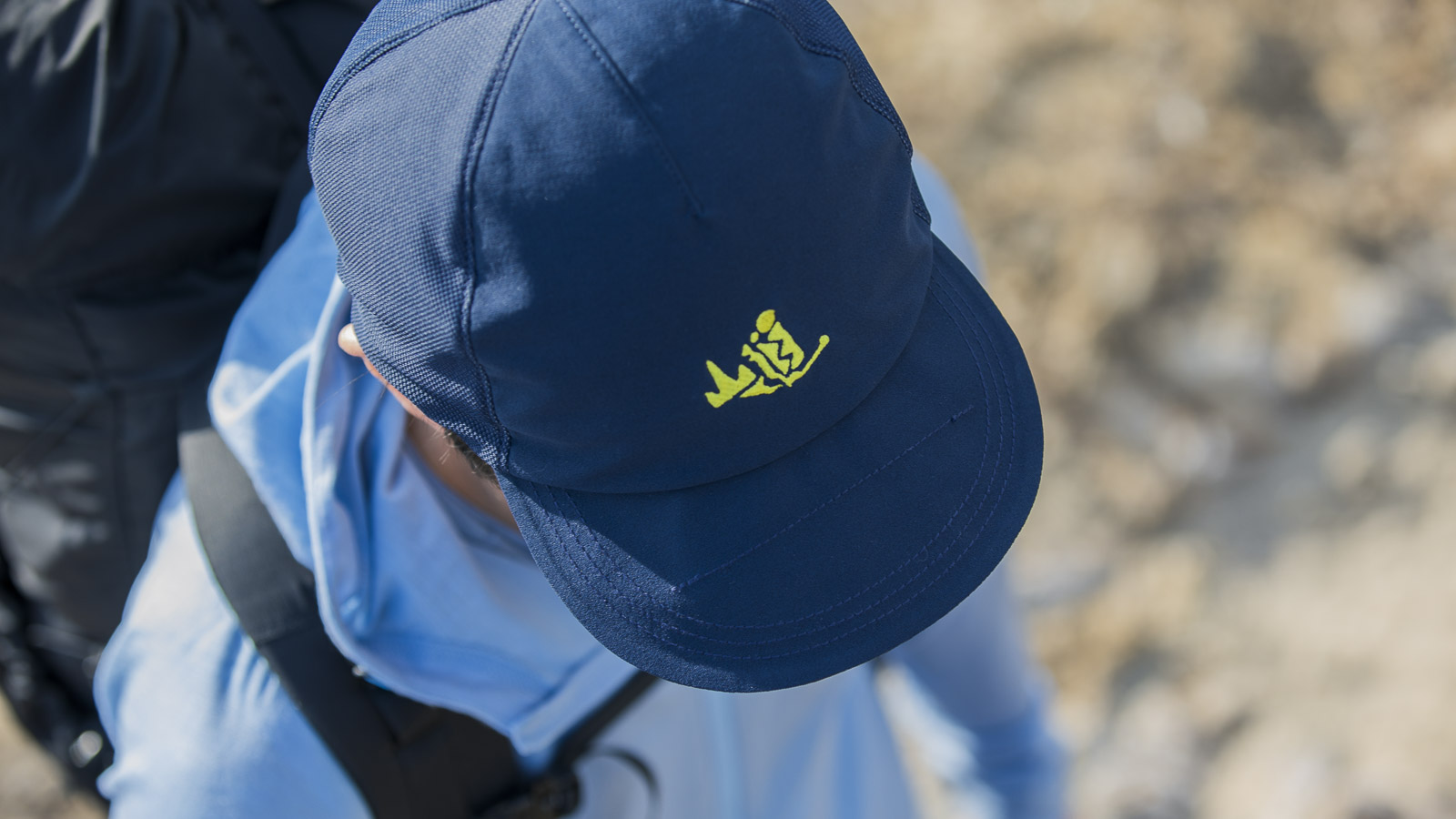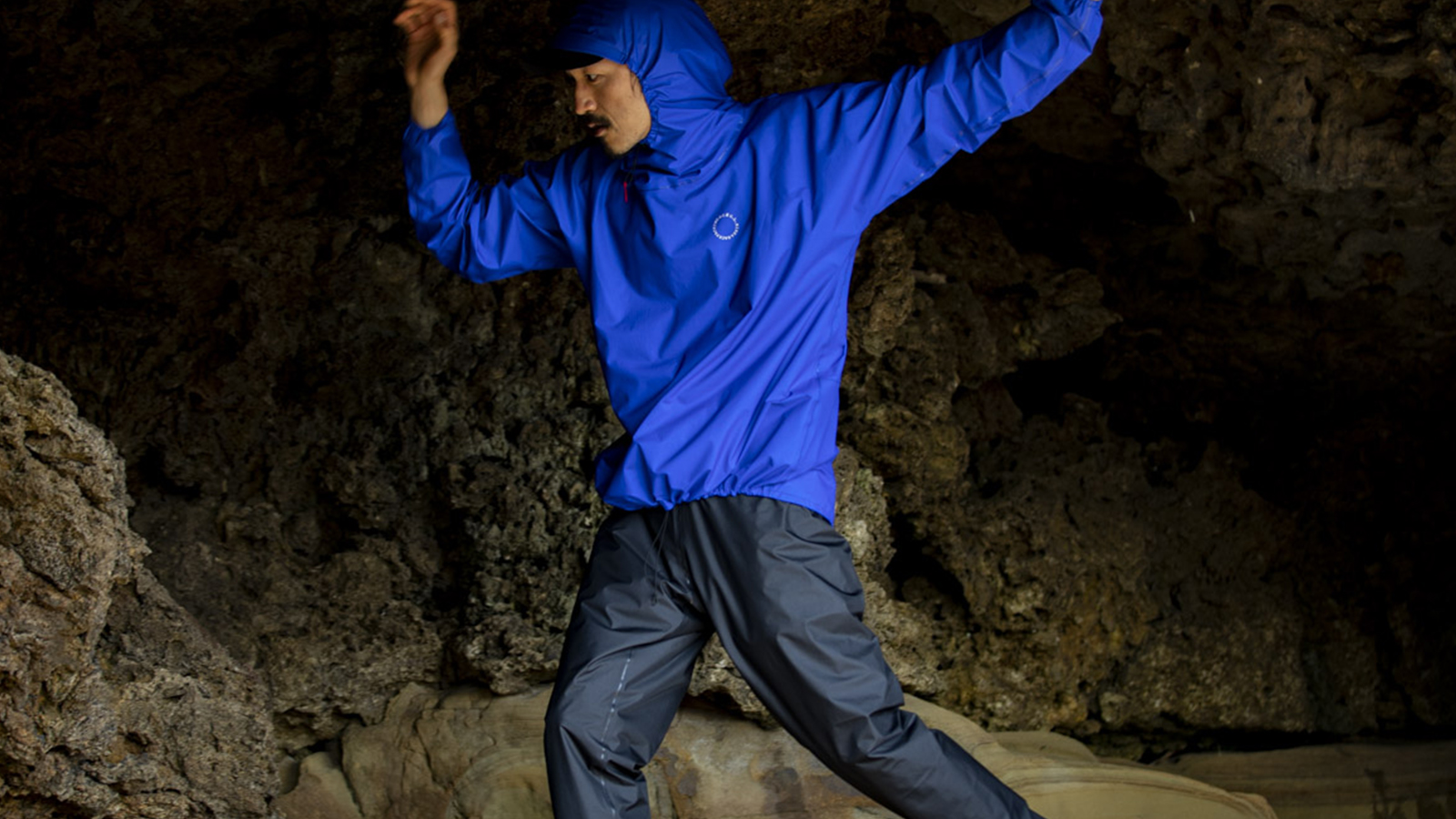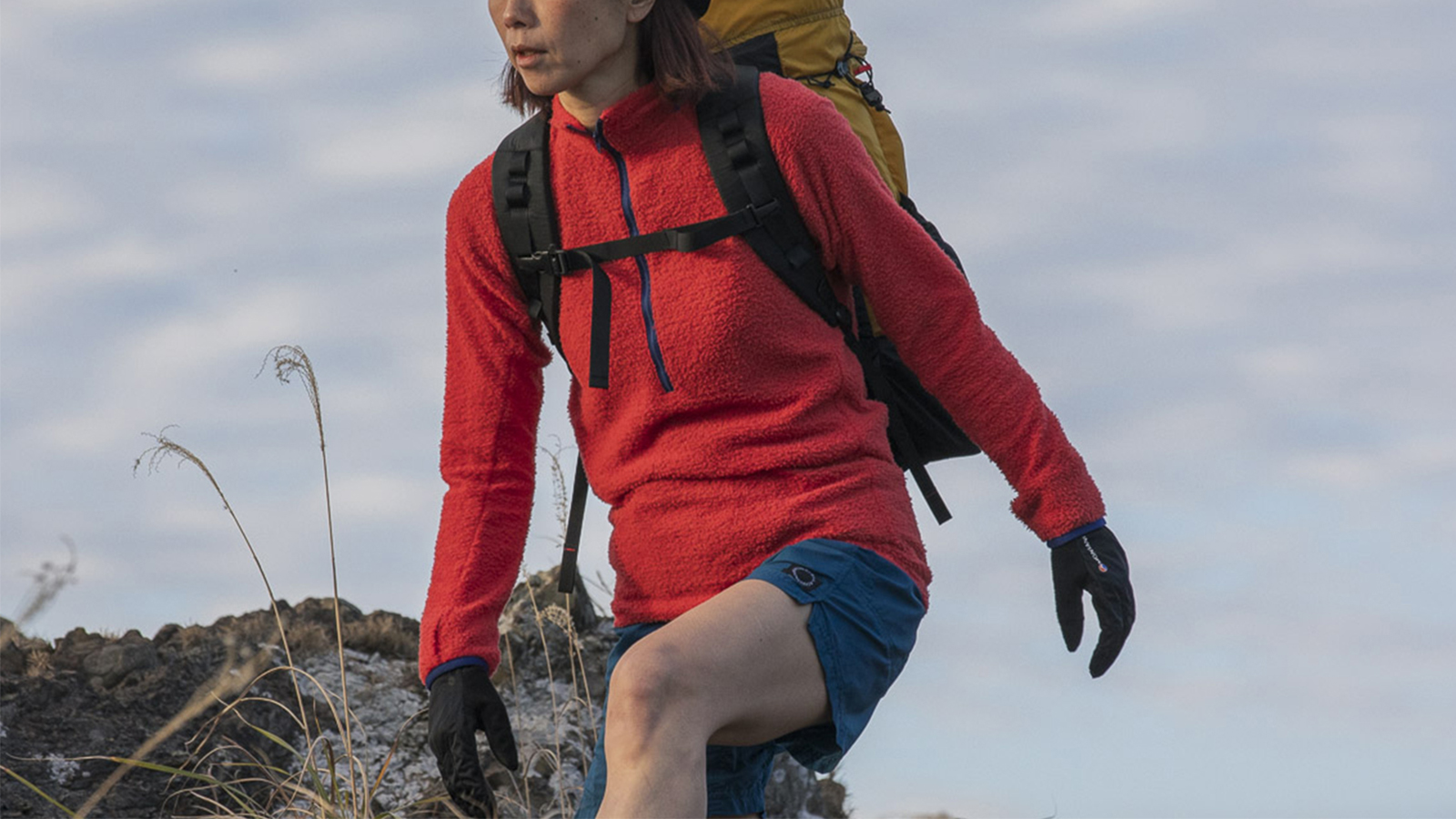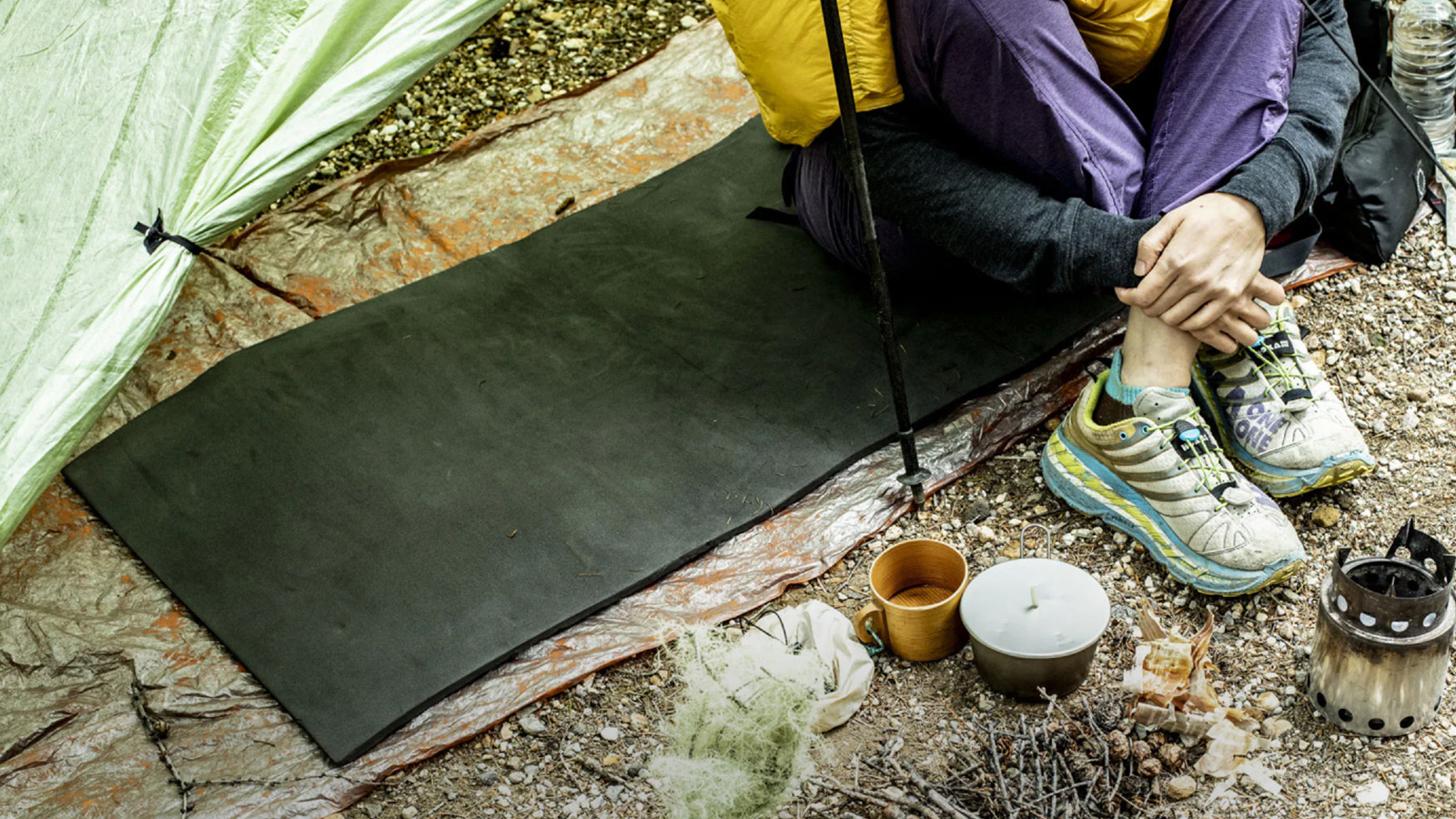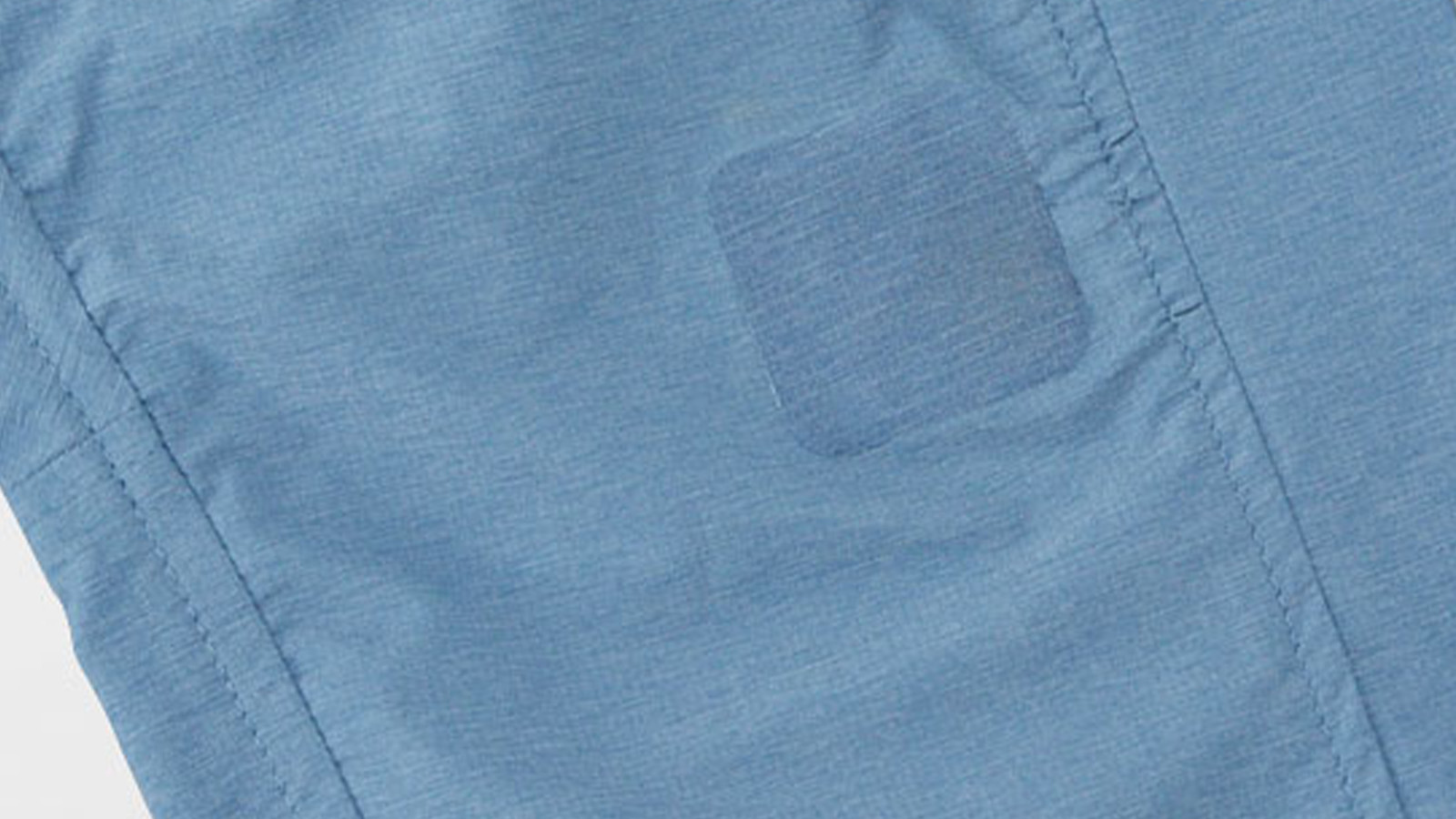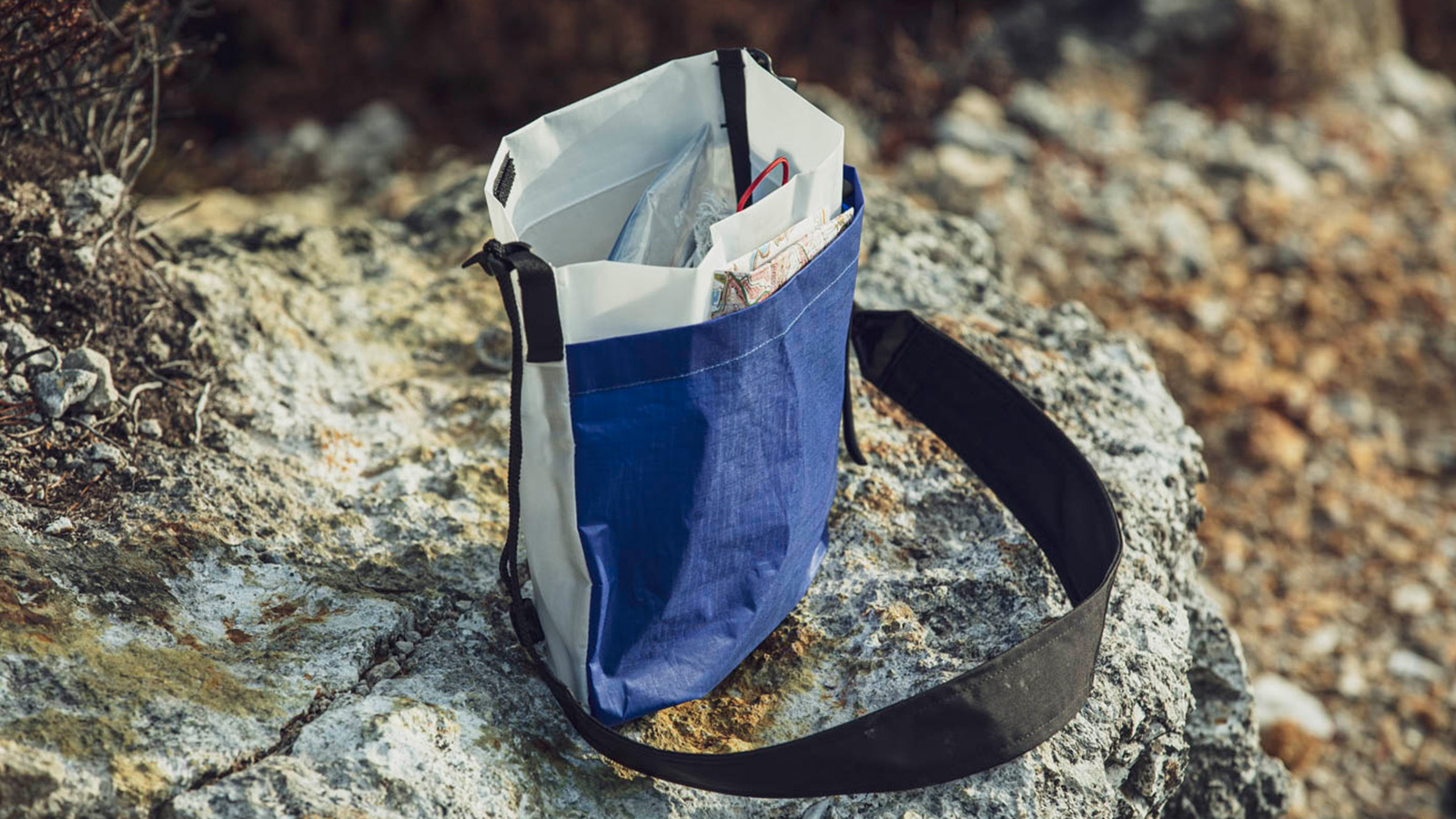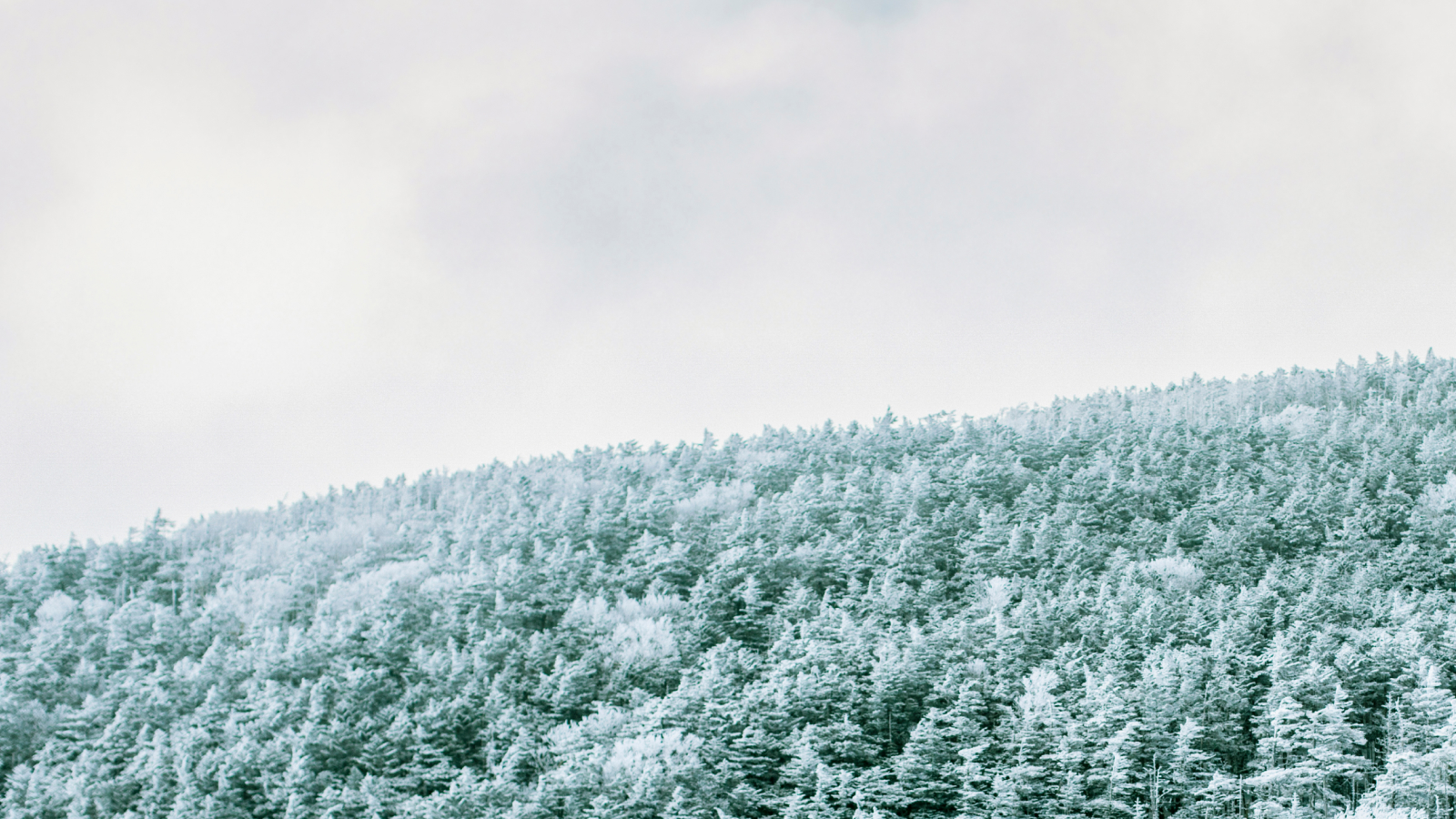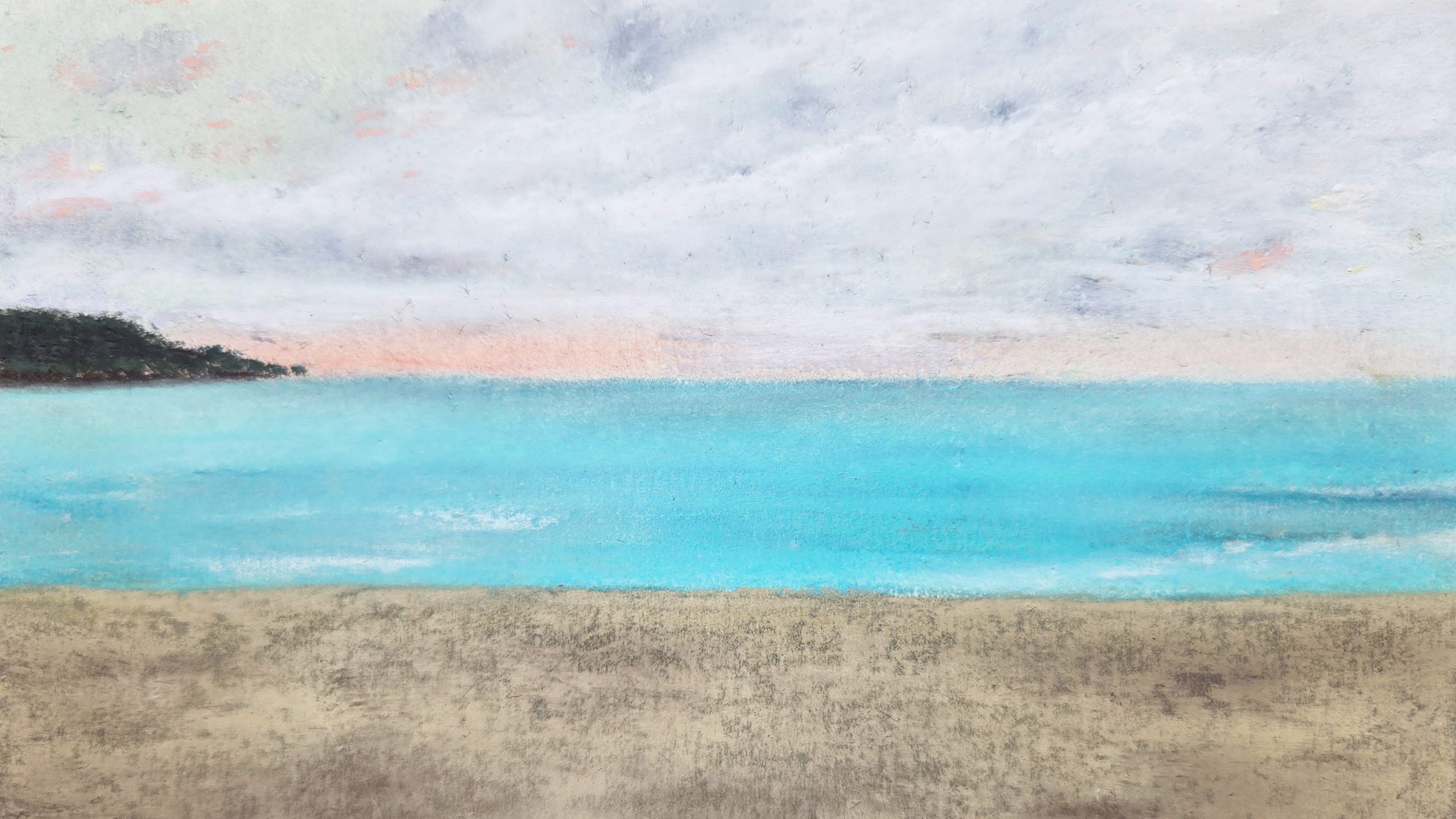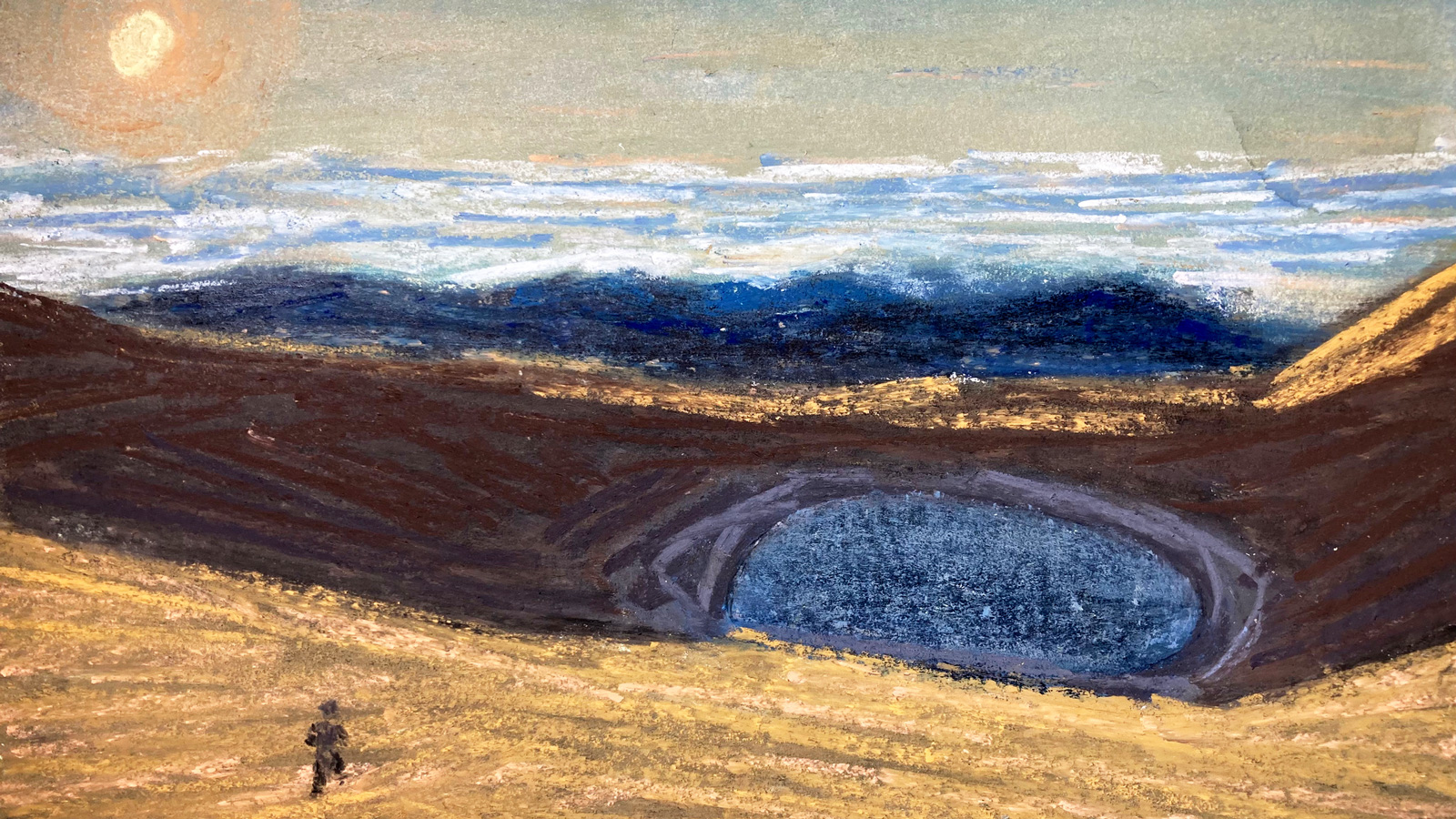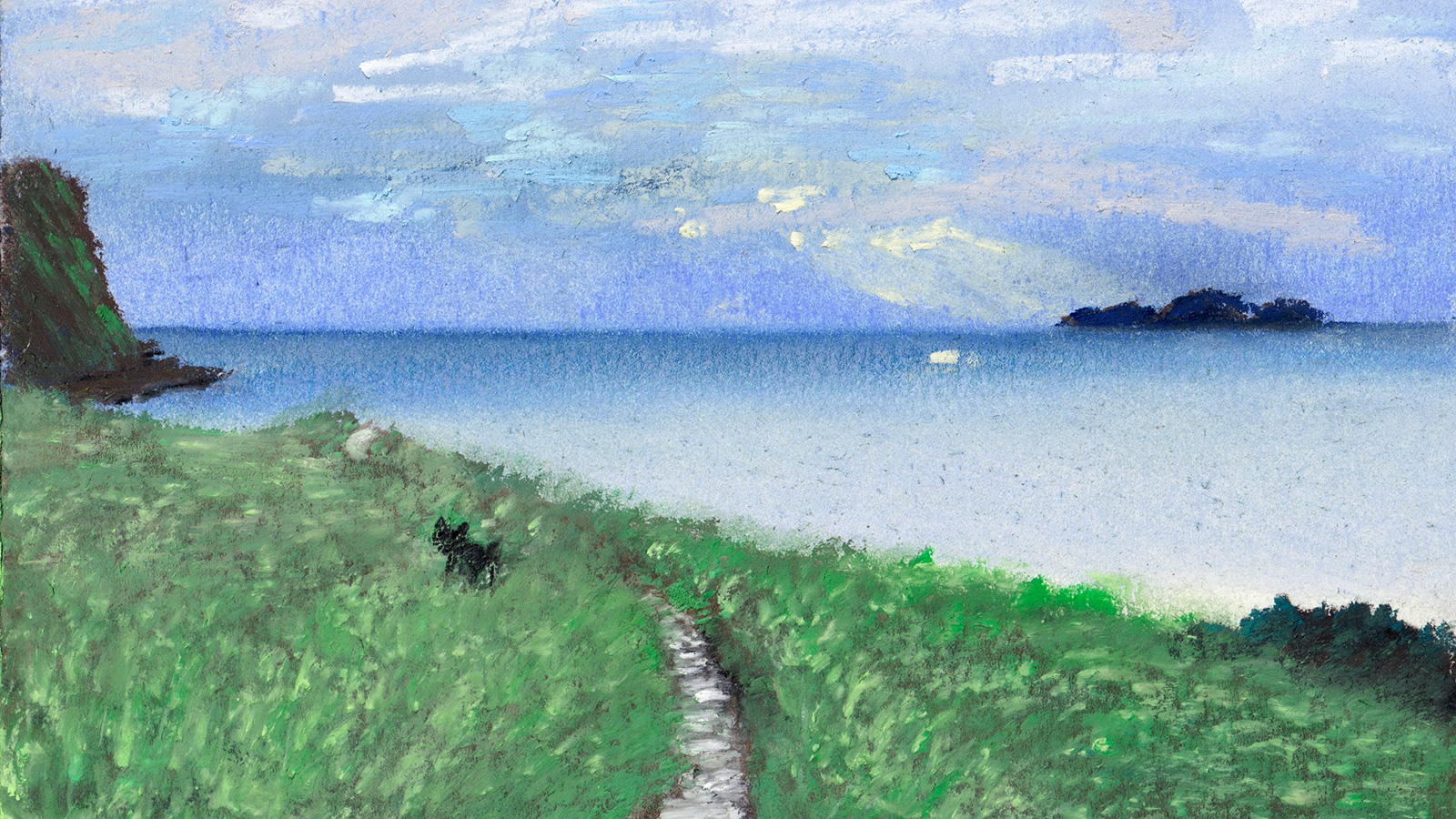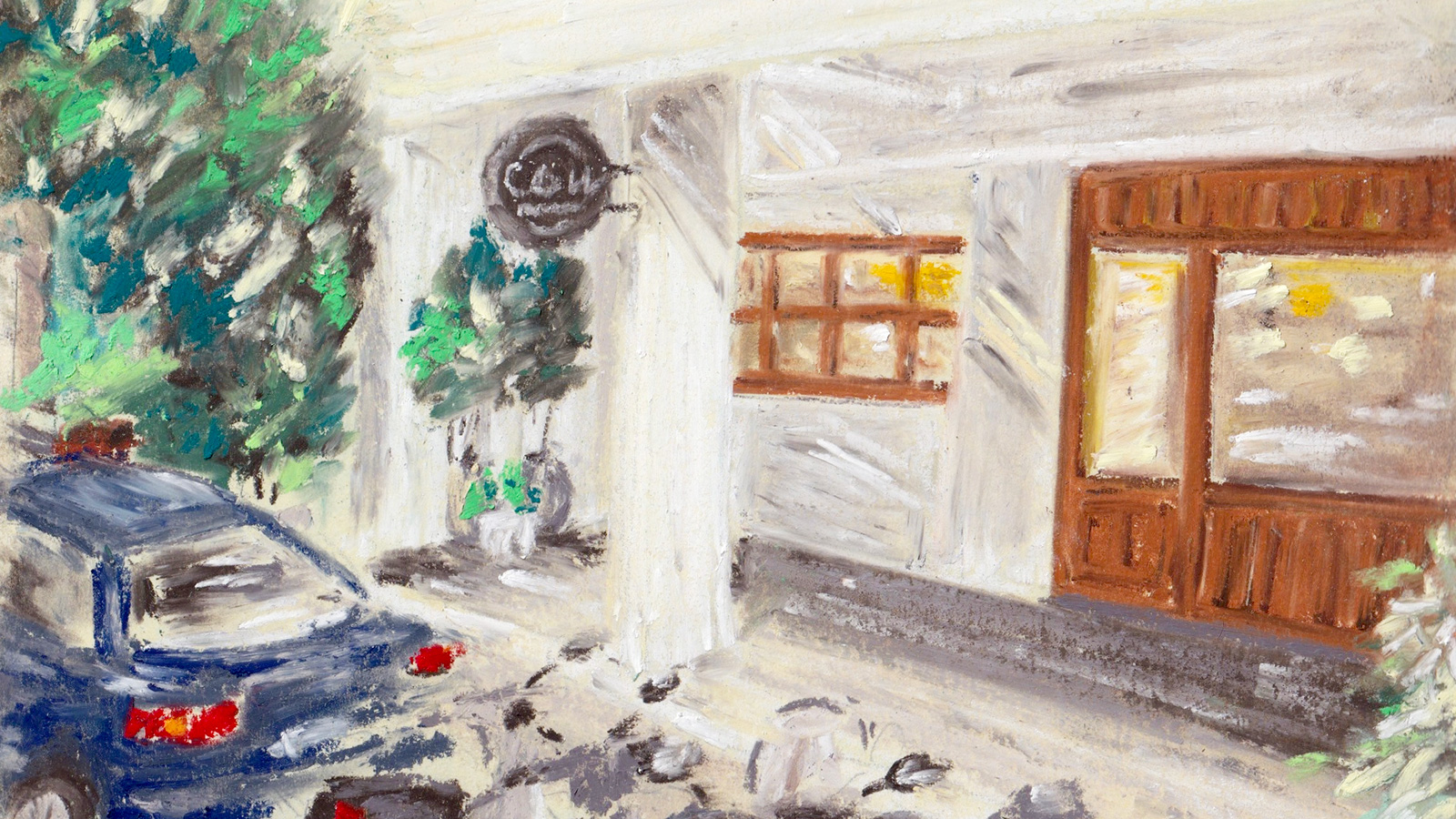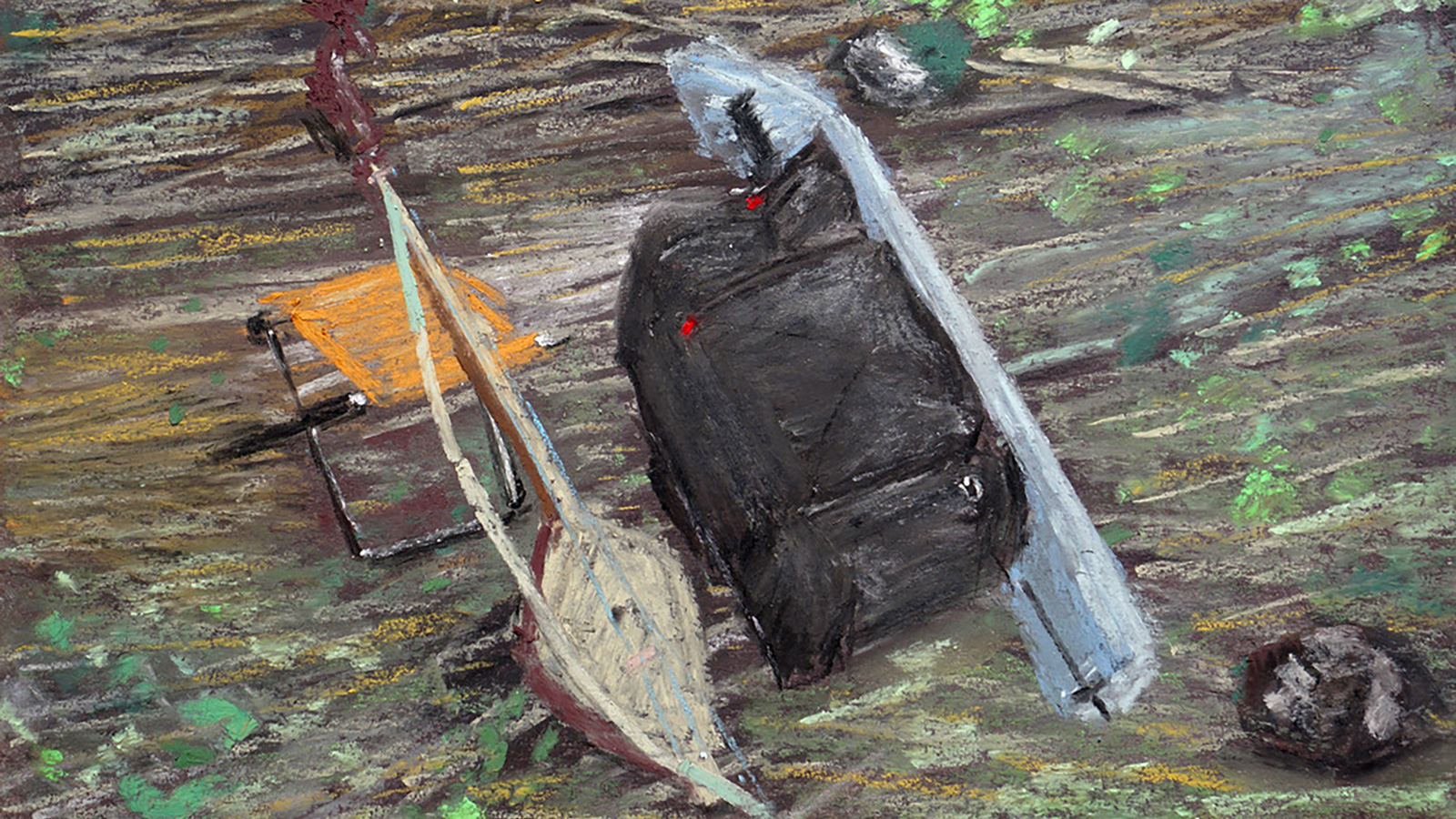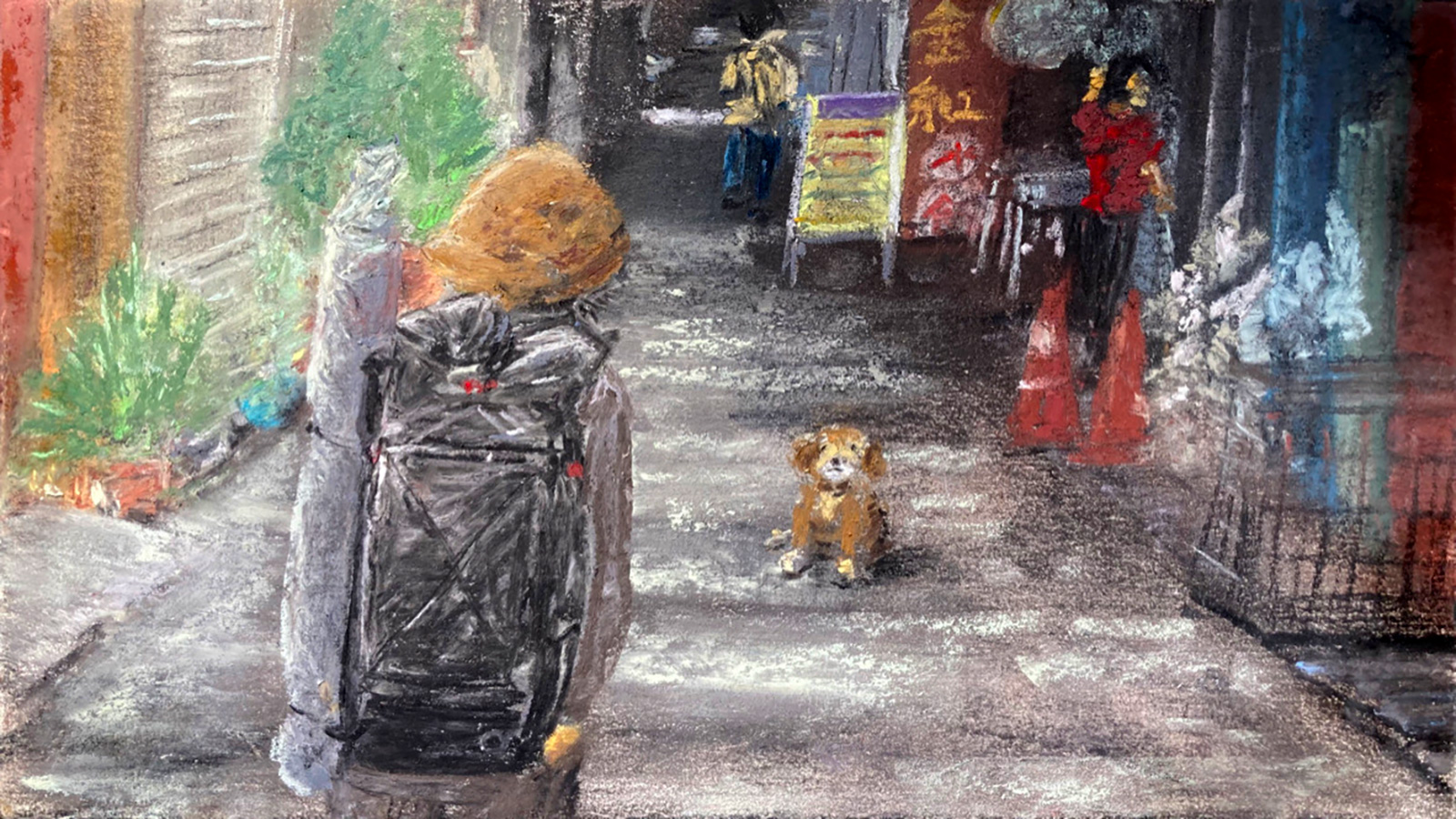#2 Getting Ready: Ultralight Gear & MYOG
#2 Getting Ready: Ultralight Gear & MYOG
Takaya Sasa is a traveler who has journeyed through over 60 countries, a musician who plays the horsehead fiddle and kalimba, a researcher of raw food and vegetarian cooking, a pastel artist, and more. Today, he lives a self-sufficient, self-built lifestyle on the banks of the Shimanto River in Kochi Prefecture, Japan.
In 2024, after 25 years of traveling, Sasa embraced the world of ultralight hiking. With a dramatically lighter pack, he spent two months walking across Taiwan.
His stories—encounters with everyday people and glimpses into local life that only a walking journey can offer—are deeply compelling. And we couldn’t help but wonder: what happens when someone like Sasa adopts the ultralight mindset? What does he notice, and how does it change the way he travels? That curiosity is what led us to invite him to contribute to the Yamatomichi Journal.
This article is the "preparation chapter," following his earlier prologue. Here, Sasa shares how he lightened his load and introduces some of the tools he made himself—each one inspired by the ultralight philosophy.
You’ll also hear from Ai Hino, co-editor of this series, and Masaaki Mita, editor-in-chief of the Yamatomichi Journal.
We hope you enjoy following Sasa’s journey once again.
How I found Yamatomichi
Before diving into the story of packing for my trip to Taiwan, I’d like to share how I first discovered ultralight hiking—and eventually, Yamatomichi.
It all began with a visit to samplus, Yamatomichi’s official store in Taipei. In fact, that visit marked the very start of my journey through Taiwan.
Just a few days before leaving Japan, I had the chance to reconnect with Masaaki, the editor-in-chief of Yamatomichi Journal, in Kamakura.
Masaaki and I had previously collaborated on an article for a magazine called
murmur magazine, though the last time we met was all the way back in late 2009—just before I left for New Zealand.
Reuniting after 14 years, we strolled from Yamatomichi Kamakura, where we had arranged to meet, to a nearby curry spot for lunch.
As we walked, we laughed about how we once created an entire article through emails exchanged between New Zealand and Japan. It was a nostalgic start to our long-overdue catch-up.
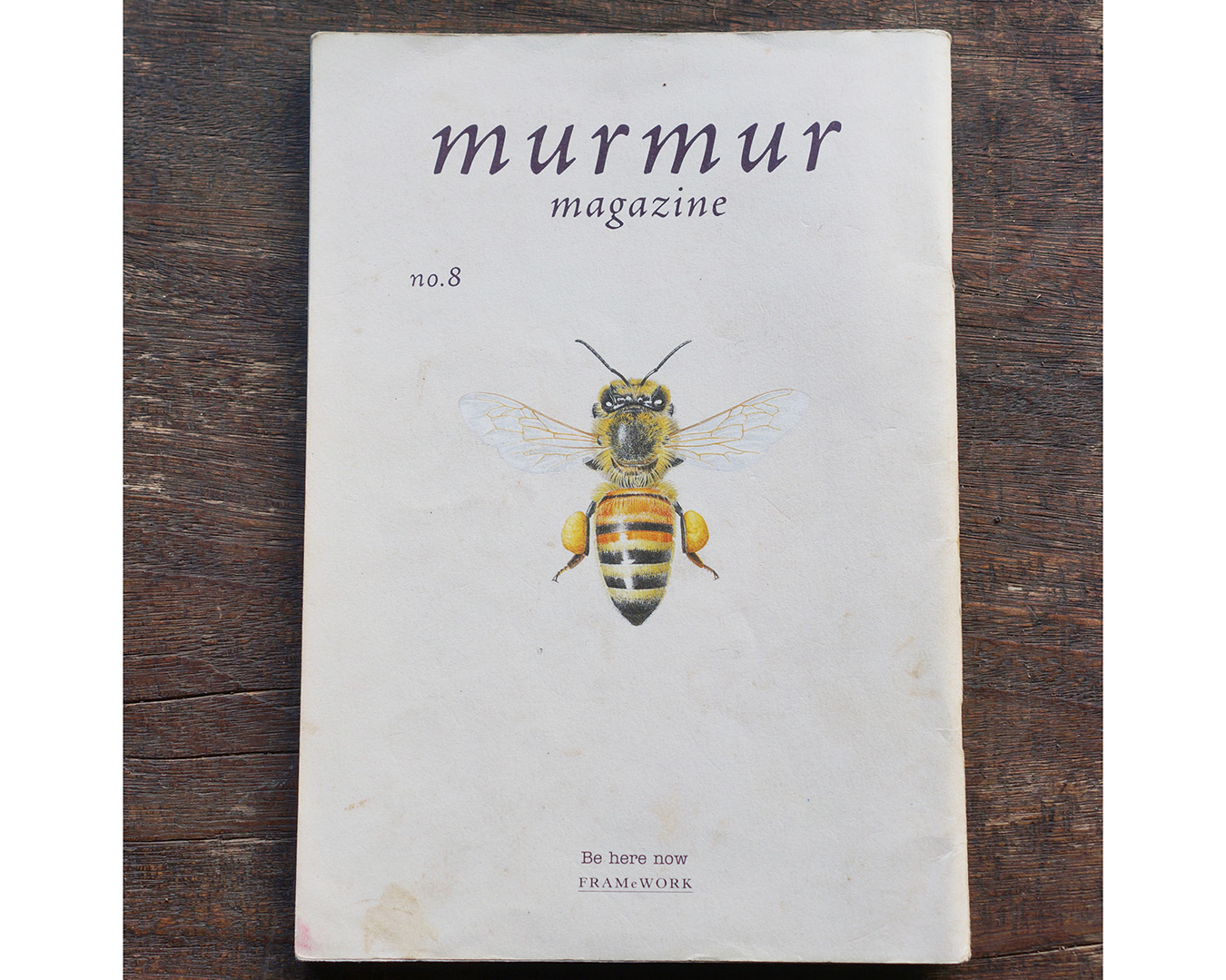
Published in March 2010, murmur magazine no.8 featured an article by Masaaki titled “The Man of Mountains and Photography: Masaaki Mita – High on Hiking”.
(Editor’s note: For this issue, Masaaki also oversaw the planning and editing of the opening feature.)
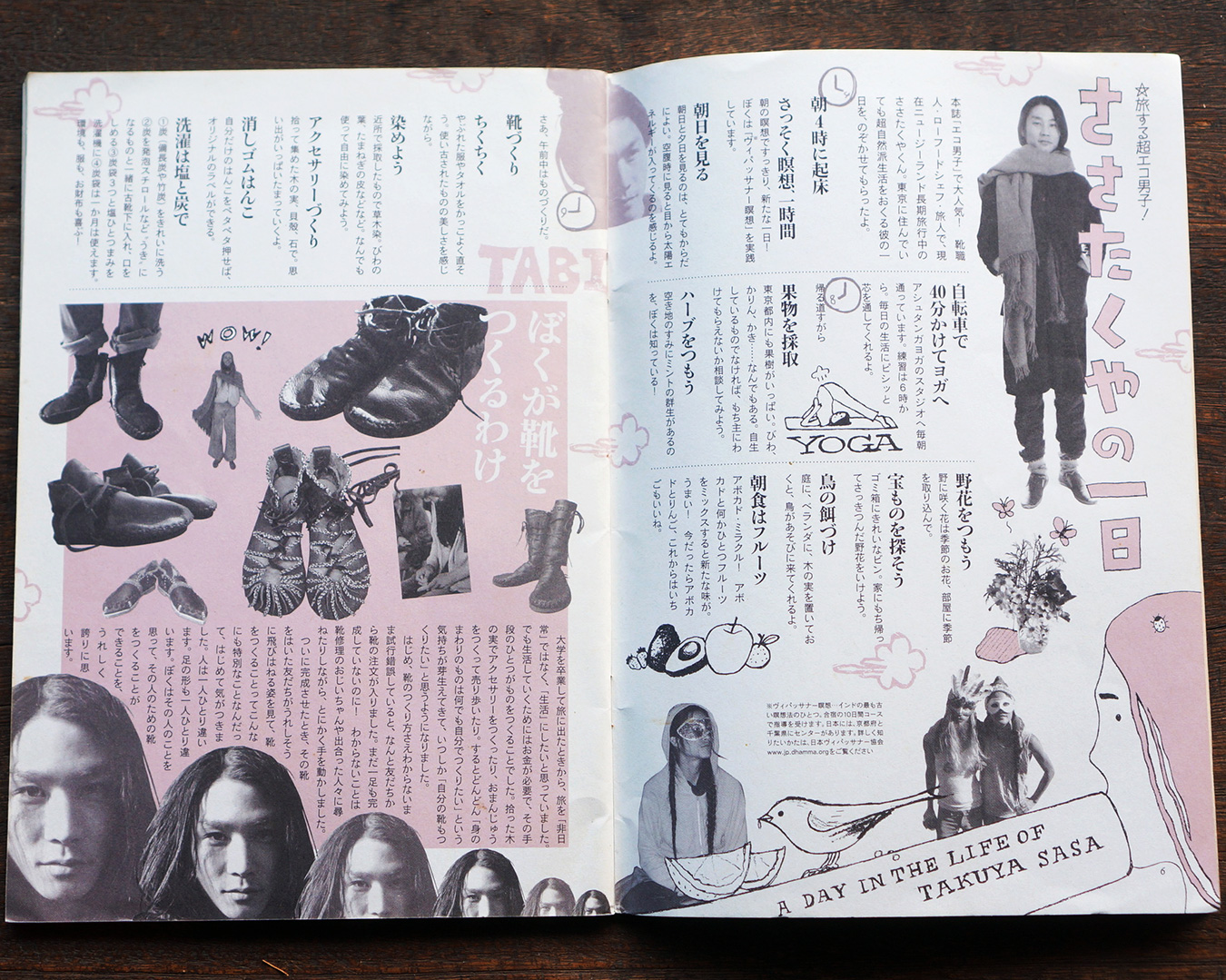

Back in 2010, I worked with Masaaki on an article for murmur magazine titled “A Day in the Life of Super Eco Guy: Takuya Sasa.”
Masaaki also created the illustrations for the piece.
(Editor’s note: At the time, during the editing process, Sasa-san had just left for New Zealand to study permaculture. As a result, Masaaki wrote the article based on a collection of ideas Sasa had shared via email about the kind of lifestyle he envisioned.)
Afterward, I also had the chance to catch up over the phone with Mirei Hattori, the editor-in-chief who originally brought us together. We shared lots of fond memories. (By the way, it turns out the name murmur magazine was actually coined by Masaaki!)
I owe this long-overdue reconnection with Masaaki to Ai-chan, who’s deeply involved in Yamatomichi’s HLC and our Journal, and also edited this very article.
We first met in Shikoku, and in 2023, we collaborated on two books together: TABI no Ohanashi-kai and Kurashi no Kage.
In fact, it was through Ai-chan that I first heard terms like “ultralight” and “Yamatomichi.”
One day, she casually said, “By the way, you know Masaaki Mita, right? I’m working with him at Yamatomichi these days.” Hearing that made me want to reconnect—and thanks to her reaching out to him, it actually happened.
Ai-chan, thank you!
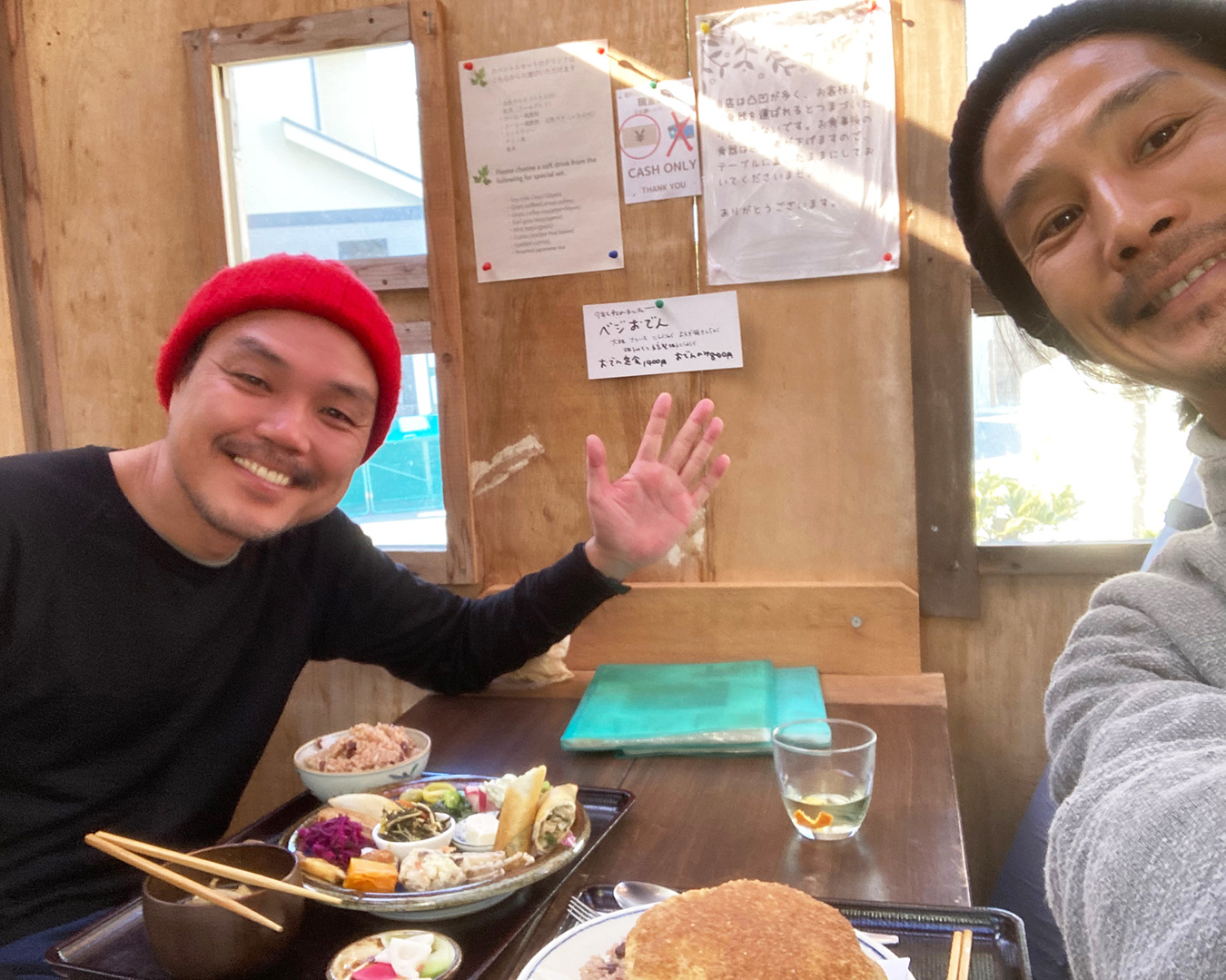
Reunited with Masaaki in Kamakura—14 years later!

Behind the scenes during my book project: Ai-chan (editor) on the left, and Akiko Masudaya from Shoei Printing (Matsuyama, Ehime) on the right.
After catching up with Masaaki and sharing a bit about what I’d been up to, I mentioned that walking the Shikoku Pilgrimage had left a deep impression on me—and that I was wondering if I might be able to do a similar kind of walking journey in Taiwan.
Masaaki replied, “I once traveled around Taiwan by bike. There were convenience stores everywhere—it was really convenient.”
That reminded me of how much I had relied on convenience stores during my Shikoku walk, and it gave me a reassuring sense that a walking trip in Taiwan might actually be possible after all.
Making it yourself is the coolest thing you can do.
At that point, I had almost no information about traveling in Taiwan. But little by little, I started forming an image of the journey by asking people who had been there before.
In my previous article, I wrote that I hadn’t done much research—what I really meant was online research. I still made a point of talking to people who had actually been to Taiwan. Not only was it helpful, but I genuinely love hearing people’s travel stories. It’s just so fun.
Naturally, I started asking about the world of ultralight too. As a total beginner, I had a ton of questions. Masaaki patiently explained the history and DIY spirit of ultralight hiking, and then wrapped it up with a line that really stuck with me:
“At the end of the day, making it yourself is the coolest thing.”
Wow. That one line lifted a weight off my shoulders.
At the time, I had fallen into the deep rabbit hole of ultralight gear. I was overwhelmed with information from blogs and YouTube, unsure what was “right” or “best,” and it started to feel heavy—mentally, not just physically.
I even found myself thinking, “I already have a travel style that’s worked for years. Why should I spend money and time trying to change it now?” That sense of resistance to going ultralight was growing in me.
To be honest, while I hadn’t researched much about Taiwan itself, once I decided to try lightening my pack, I became obsessed with researching ultralight gear online. It got to the point of total information overload. (If you’ve been there too, I highly recommend reading Masaaki’s article “Cheap Hike”. It gave me the courage I needed to move forward.)
But when it comes to DIY—well, I actually do have a few things in my pack that I made myself!
Two of my most essential travel companions are instruments: a horsehead fiddle from the Republic of Tuva (just north of Mongolia, known locally as an igil), and a kalimba, an African thumb piano. Back in my twenties, I used to perform with them on street corners while traveling to earn money. I still perform from time to time, and this trip would be no exception. Whenever I felt lonely on the road, music always lifted my spirits. Instruments are truly my best travel companions.
For years, I carried the kalimba in a leather case I made myself, drawing on my experience as a shoemaker. But now, weight matters more than style. Leather, while beautiful, is heavy. So I built a new case out of plastic floor-protection mat from the hardware store. To make it a bit more presentable, I covered it with washi paper and brushed on some persimmon tannin dye. Now it’s both light and stylish—because let’s be real, style is a function too!

On the left is the old leather case, and on the right is the new one made from a plastic floor-protection mat. The sheet in front is the mat I used as the base material.
As it turned out, the bag I made for my horsehead fiddle became something more than just a protective case—it evolved into a clever piece of multi-use gear.
Back when I walked the Shikoku Pilgrimage, I used to slide the fiddle into the side pocket of my backpack. To keep it dry, I had asked a friend who’s handy with a sewing machine to upcycle an old bivy sack into a waterproof bag. It did the job beautifully. But this time, without planning to, I ended up upgrading that setup in a way I never expected.
It started with sleeping gear. I’ve always been an air mat kind of person—until, of course, one punctures in the middle of a trip. You wake up freezing, try patching it half-asleep, and it never quite holds. So for this journey, I decided to try something different: Yamatomichi’s UL Pad 15+ (100cm).
When it arrived—bam! It was way bigger than I imagined. No matter how I rolled it or folded it, it just wouldn’t pack down like an air mat. Online shopping: forever a gamble.
But then I had a thought: “This thing is light, flexible, and cushions well… what if I used it inside the fiddle case?” I slipped it in, and to my surprise, it fit like it was made for it. At night, I could pull it out and sleep on it. During the day, it protected the instrument. A perfect dual-use solution. I had that rare, satisfying moment when form, function, and necessity align—you just know you’ve nailed it.
Fueled by that win, I went a step further. I decided to make a custom pack liner for the fiddle bag, taking cues from Yamatomichi’s Pack Liner—the kind that keeps your gear dry even if the backpack gets soaked. I pulled out an old liner I’d bought over a decade ago before a trek through New Zealand’s national parks, cut it down, and re-sewed it to size. Then I ditched the drawstring opening for a roll-top closure, dry-bag style, to boost its waterproofing.
And just like that, the horsehead fiddle bag version 2 was born: lighter, tougher, and ready for anything.
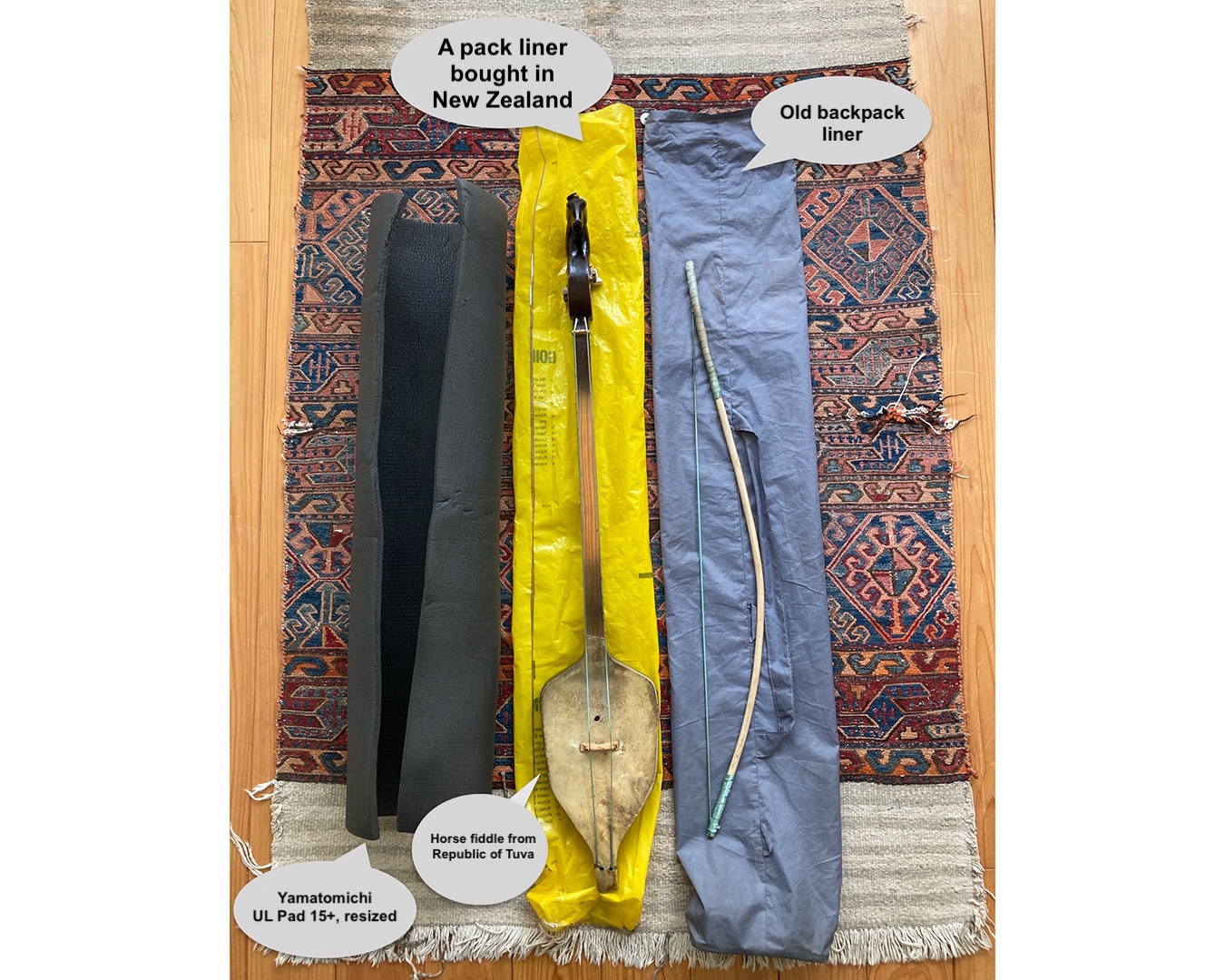
My self-made horsehead fiddle case set.

The upgraded roll-top fiddle case—waterproof and impact-resistant. I nearly gave up on the bulky sleeping pad, but it’s been worth it for a comfy night’s sleep.
There’s definitely a special feeling that comes from traveling with gear you made yourself—like you can’t help but puff your chest out a little with pride. And because you made it, you know exactly how it works. If it breaks, you can fix it. Sure, it might not perform as well as something store-bought, but that’s okay.
While traveling, I often notice small ways a piece of gear could be improved for better usability. When that happens, I just tweak it. That’s why I always carry a sewing kit as part of my pack. Constantly upgrading handmade gear sharpens not just the tools, but also your awareness and intuition. In a way, that process itself is another kind of journey.
Maybe that’s exactly what Masaaki meant when he smiled and said, “Making it yourself is the coolest.”
What I carried on my journey
Alright… it’s a little embarrassing, but here’s my full gear list from the start of my Taiwan trip—along with some commentary.
[Clothing for Hiking]
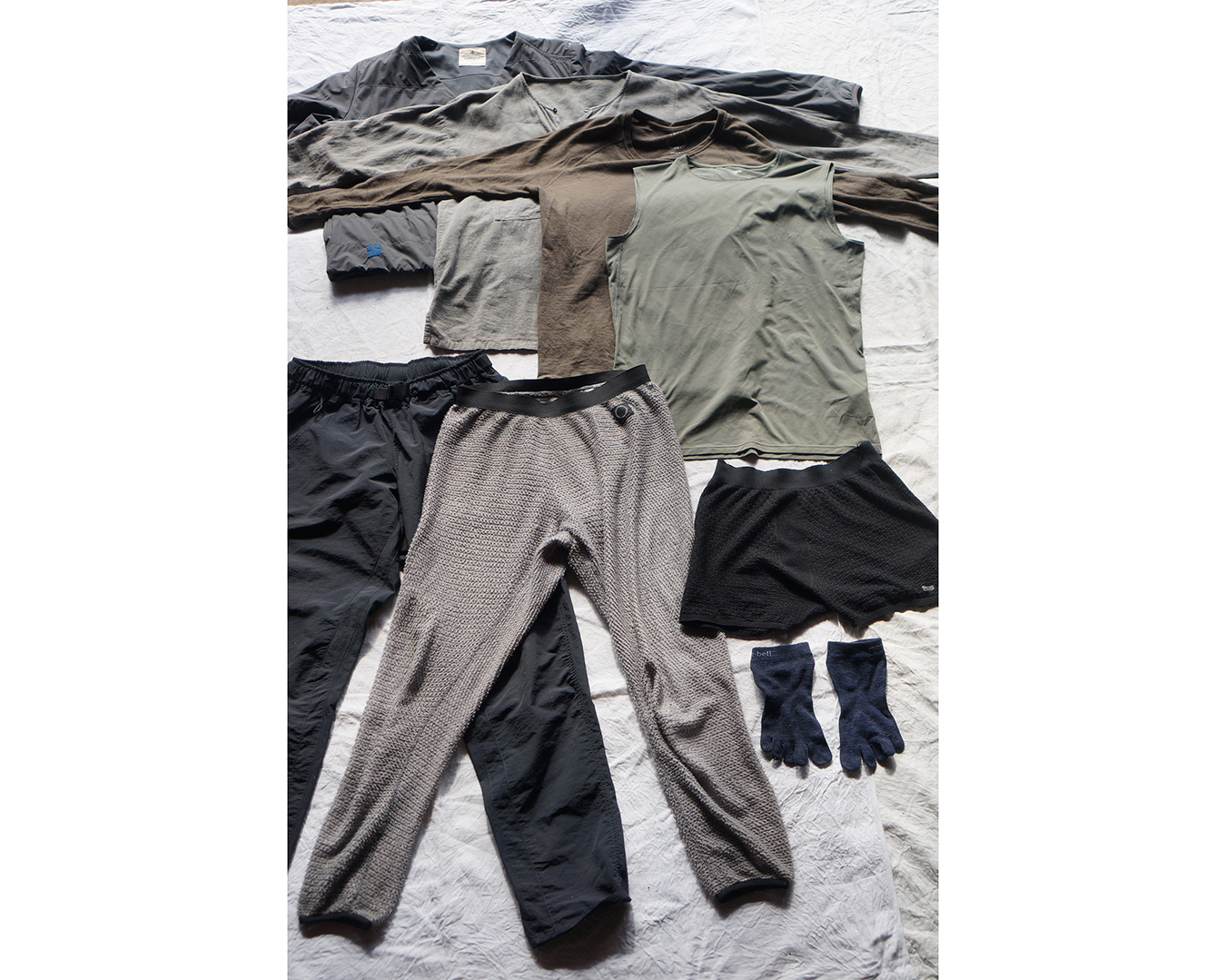
This was what I wore when I left Japan in January. Surprisingly, Taiwan was colder than expected, so this outfit worked out well. In higher mountain areas, though, it wasn’t quite warm enough. I didn’t bring any extra underwear or socks for this trip.
(from top left)
Snow Peak: Flexible Insulated Cardigan
I bought this a few years ago on a cold day while walking the Shikoku Pilgrimage—just happened to pass by a shop. I like the stylish design, which works well in town too. The neckline can be chilly, so I pair it with a scarf.
Emiowasu: Pocket Shirt
Made of cotton. The large chest pocket feels secure and practical. I love its traditional, almost folk costume-like shape.
Yamatomichi: DF Mesh Merino Long Sleeve
Super lightweight and dries quickly—really useful. The merino blend is also very comfortable to wear.
Houdini: Men’s Pace Air Tank
I prefer sleeveless tops. T-shirts often feel too tight around the shoulders or trap heat, so I tend to avoid them.
Yamatomichi: 5-Pocket Pants
I was seriously impressed by the storage capacity of these pockets. I could walk around comfortably without a bag, and even when sitting or lying down, the back pockets never got in the way. I often slept on public transport or while wild camping with my passport and wallet still in the back pockets—and felt completely secure.
Yamatomichi: Light Alpha Tights
These were also great—lightweight and quick-drying. For comparison, I used to wear Montbell’s Super Merino Wool (midweight) tops and bottoms as my base layer.
Bring: Wonder Wear One 50/50
I traveled for two months with just one pair of these famously “four-day wear” underwear. I’d wash them at night, go commando under my shorts, and sleep like that—yep, really!
Montbell: Kamiko Travel 5-Toe Ankle Socks
They stayed dry and breathable while walking, and didn’t smell. I like five-toe socks because they let my toes move freely. No issues putting them on in the morning, but they could be a bit annoying to take off when damp or after swimming—they’d snag on my toes and slow me down a bit.
[Other layers]
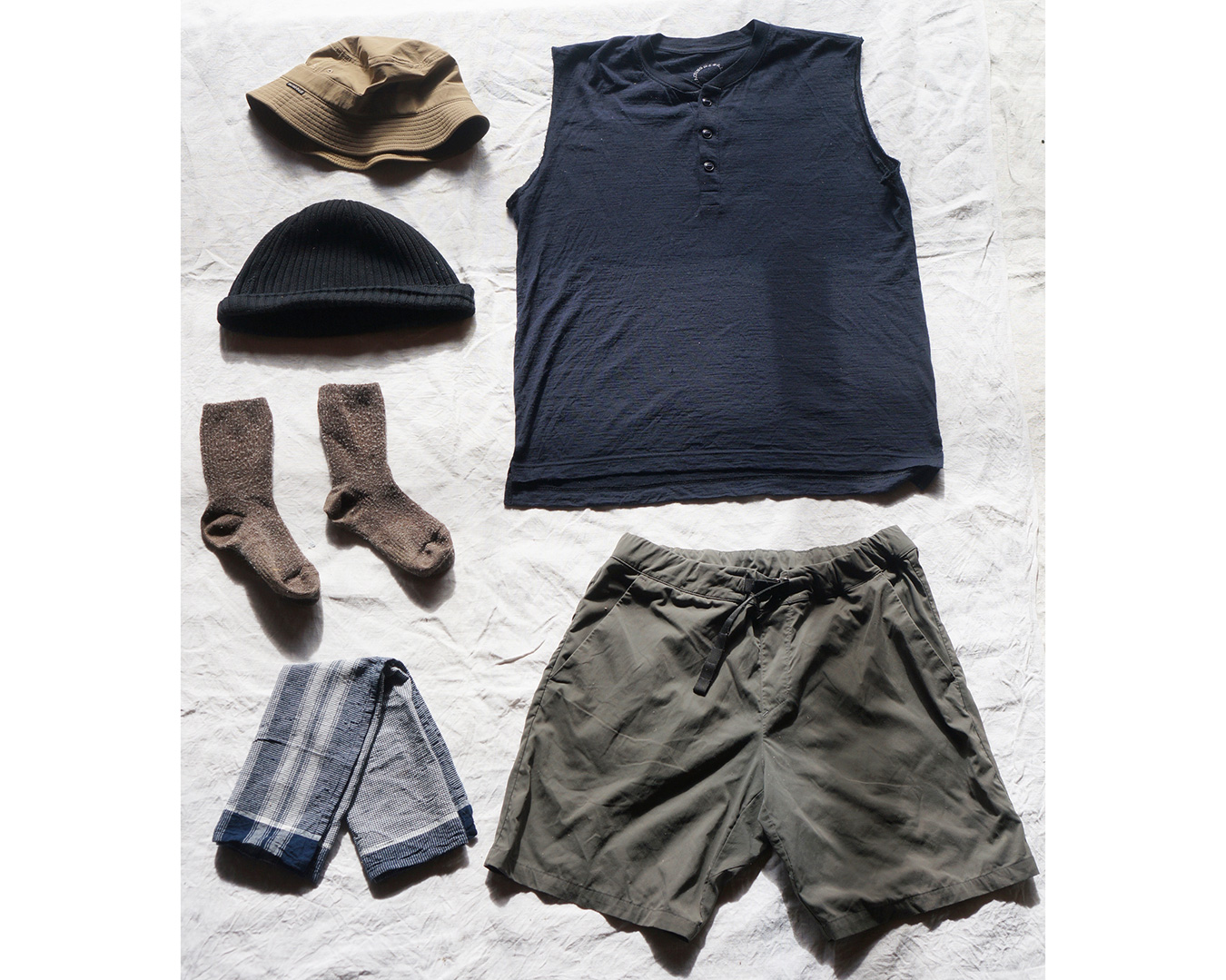
(from top right, clockwise)
Yamatomichi: 100% Merino Light Henley
(In the photo, the sleeves have been cut.) I brought this as a change of clothes for sleeping. Normally, I wear sleeveless base layers, but since I had plans to stay at a Vipassana meditation center in Taiwan—where bare shoulders aren’t allowed—I packed a short-sleeve option.
Still, I couldn’t get used to wearing sleeves, so after the stay, I cut them off. Now it’s sleeveless again.
Houdini: Men’s Wadi Shorts
Worn for sleeping and as swimwear.
MUJI: Fine-Thread Indian Cotton Multi Cloth
Made by sewing together two Indian cotton handkerchiefs. It dries quickly and feels great on the skin. I used it as a towel, scarf, and pillow cover.
Scarves are essential for me—for warmth, style, and versatility. One large cloth can also work as a makeshift bag, belt, or sunshade. I always carry one when I travel.
Bring: Wonder Wear Socks
Wool socks for sleeping or staying warm on cold nights.
omotesando atelier: Tight-Fit Knit Cap
I love knit caps as a style item too. Since travel temperatures can vary a lot, I go with cotton instead of wool for flexibility.
Montbell: South Rim Hat
My go-to for sun protection while walking. I prefer hats over caps.
【Rain gear】

(top)
Houdini: The Orange Jacket
Used for rain, wind, and warmth. It’s about the size of an orange—light, compact, and easy to stash in a pocket. Super convenient and got a lot of use.
(bottom)
AXESQUIN “Ryo” Series: Tsuyuharahi
This time, I chose a rain skirt instead of rain pants. Like the scarf I mentioned earlier, it’s essentially one large piece of fabric, so I could use it in all kinds of ways—backpack cover, groundsheet, tent extension—you name it. It was fun to experiment with.
[Shoes & Sandals]
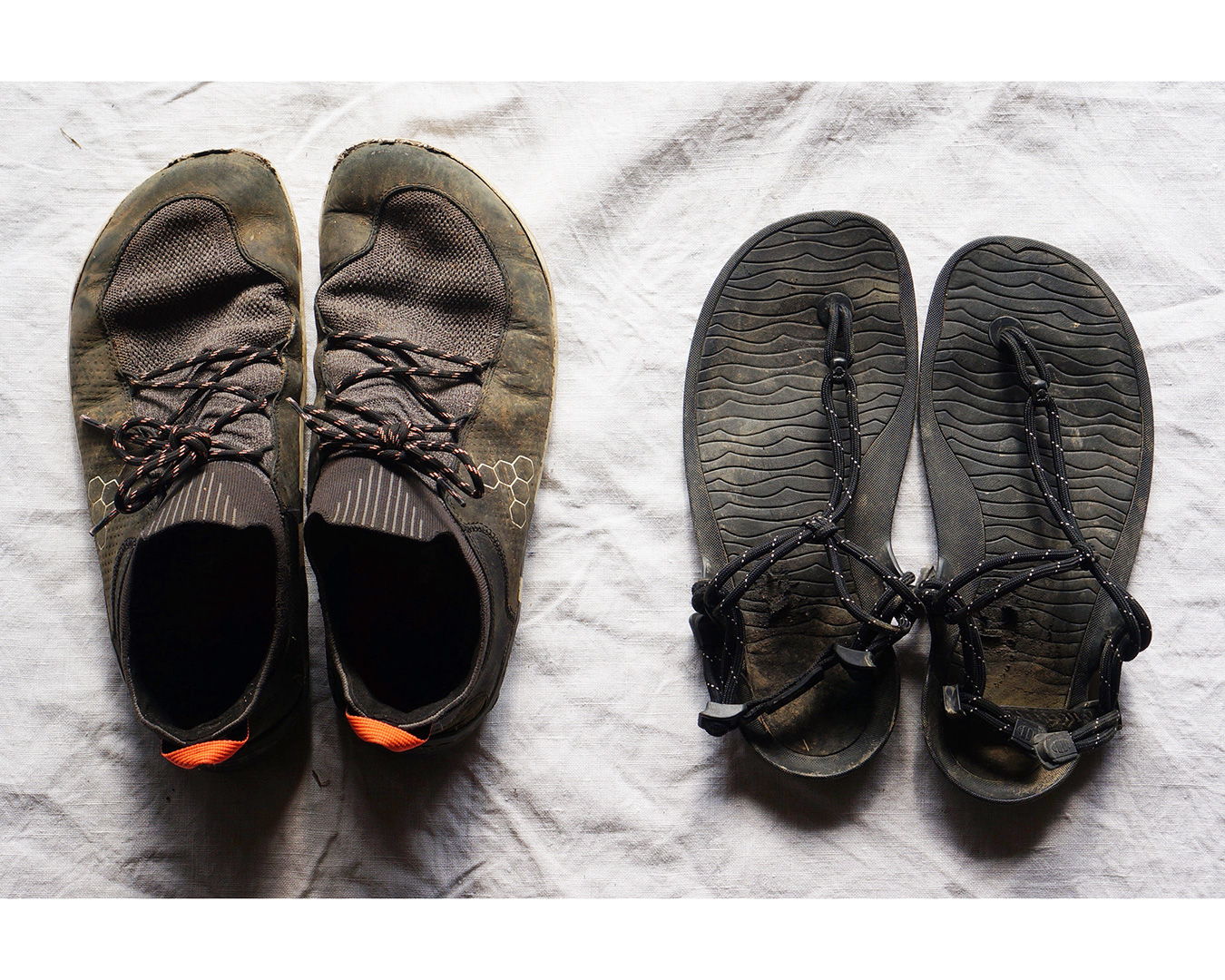
(left)
Vivobarefoot: Tracker Decon FG2
I’ve completely fallen in love with barefoot shoes. Even though I walked a lot on asphalt this trip, I didn’t miss the cushioning at all. In fact, once I started feeling the ground through my toes, it felt like I was using my feet the way they were meant to be used—so much so that it even felt mentally refreshing.
They’re also super light, so even when I was wearing sandals, carrying them wasn’t a burden. That was a big plus.
(right)
Xero Shoes: Aqua Cloud
I used to wear sandals with heavy-duty Vibram soles, but looking back, they were definitely on the heavy side. Switching to these lighter sandals had an immediate impact on how I moved. It’s fascinating how simply changing your footwear can shift your entire mindset and experience.
[Cooking System]

(top row)
Mesh Bag from a Natural Foods Store in New Zealand
Used as a sprouting bag to grow beans inside my backpack. I’ll share more about how I do this in a future post—stay tuned! Originally, this type of bag is meant for portioning produce like fruits and vegetables when shopping at markets or stores.
(middle row, from left)
Evernew: Blue Note Stove Set
An alcohol stove. It was surprisingly hard to find fuel alcohol in Taiwan. Gas was much more accessible—looking back, a gas stove might have been the better choice.
Evernew: Double-Cap Alcohol Bottle 30ml
I brought this to carry small amounts of alcohol fuel, but in the end, I had to buy larger bottles (like 900ml) locally. This made me realize alcohol stoves might not be ideal for long trips.
Titan Mania: Titanium Folding Spoon
A durable metal spoon I’ve used for years—great for slicing into bananas, avocados, and more.
(bottom row, from left)
Evernew: Titanium Mug Pot 500
Perfect size for solo cooking. One thing I love about titanium is that even when I pour in hot liquid, the rim doesn’t get scalding hot. (Tip: drink from the spout to avoid burning your lips.)
※ Please note that heat sensitivity varies by person. I’ve burned my lips in the past with other metal cookware, so this is a big deal for me.
Evernew: DX Stand for Alcohol Stove
Functions as both a pot stand and windscreen. It also worked well as a compact campfire grill.
DIY: Plastic Cutting Board
Since I prefer to cook for myself and eat fresh fruits and vegetables, I carry a small plastic cutting board. I cut it from a Daiso board to fit neatly into my cook set.
[Stationery, Gadgets & Toiletries]

(top row, from left)
① Case – Daiso: Double-Zip File Case (A5)
Used to hold a B8 pencil, sharpener, eraser, and a 3-color pen.
② Notebook – Moleskine: Cahier Journal
Blank pages for journaling and sketching. I love how smooth it feels to write on, and the sturdy paper holds up well through long trips.
③ Colored Pencils – MUJI: 12-Color Set
Nice soft leads, just the right texture. Still searching for art supplies that feel even better to draw with—something closer to pastels I use at home.
④ Mobile Battery – TNTOR: 10,000mAh
A thoughtful gift from Ai-chan before my trip. The 10,000mAh capacity gave me peace of mind. I heard it was originally recommended by Ōji from the Yamatomichi Kamakura staff.
⑤ Adapter – Anker: Nano II 45W
Compact and lightweight USB adapter with charging cable.
⑥ Headlamp – NITECORE: NU25 UL (400 lumens)
Rechargeable via USB Type-C. Lightweight and super bright.
(bottom row, clockwise from left)
⑦ Pouch – Montbell: Travel Kit Pack M
Used to store the following items:
⑧ Water Filter – Sawyer: Micro Squeeze Filter
Came in handy for drinking water in both nature and urban areas where tap water was questionable. Saved me from having to carry extra weight in water—an essential piece of gear and a comforting “just-in-case” item.
⑨ Sewing Kit – MUJI: Portable Sewing Set
I swapped in my own essentials like thicker needles, pins, and thread colors I use most often.
⑩ Swiss Knife – Victorinox: NailClip 580 T
Compact tool with nail clippers, file, scissors, and knife—all useful on the road, including for cooking. I liked the wood-grain design, but I overlooked that it doesn’t come with tweezers (the basic red plastic model does).
⑪ Eye Mask & Earplugs
Always pack these for flights and overnight transport. Quality sleep is key.
⑫ Comb
With long hair, I comb it after bathing to help it dry faster.
⑬ Nova Scotia Fisherman: Rescue Balm
A multi-use balm for cuts, lips, and dry skin. Super handy.
⑭ Toothbrush & Salt (in a film canister)
Salt doubled as toothpaste, seasoning, and even soap. Film canisters are perfectly sized and seal well—though they’re hard to find these days!
⑮ Bandages – Band-Aid: Hydro Seal
Stick one of these on a wound and you’re good to go—less hassle during recovery. Really useful.
[Everything Inside My Backpack]

① Backpack – Yamatomichi: MINI and Pack Liner
Since I started using the MINI, my view of travel has changed. I first chose it because it worked for both business trips and casual city walks. Its frameless back panel let me roll it up and stash it inside a larger suitcase as a secondary bag. But now, thanks to trimming down my gear through the ultralight way, I travel with just the MINI alone. I feel like backpack choice reflects your entire travel philosophy.
② Groundsheet – DuPont: Tyvek R Silver (1×2m)
I used to think you needed something thick and tough, but this super-light, thin sheet held up just fine.
③ Sleeping Pad – Yamatomichi: Minimalist Pad (included with the backpack)
At night, I used this under my lower body and pulled out the UL Pad 15+ (which was stored in my horsehead fiddle case during the day) for the upper half. Joined together, they worked great.
④ Tent – Six Moon Designs: Gatewood Cape
A floorless tent that doubles as a poncho. I chose it because I could also cover the instrument on my back when walking in the rain. It was my first time using a floorless shelter, so I was nervous… but how did it actually go? (That’s a story for later.)
⑤ Stuff Sack – Yamatomichi: Stuff Pack XL
I mainly used this for food and cooking gear.
⑥ Cooking Gear
(See the [Cooking System] section above.)
⑦ Shoulder Bag – Montbell: U.L. Mono Shoulder L
My go-to second bag for day outings and city walks. Just the right size for a sketchbook and water bottle.
⑧ Inner Organizer – MUJI: Nylon Mesh Bag-in-Bag (A4)
Fits perfectly into item ⑦ above—and also perfectly in the MINI’s front pocket! The smaller compartments prevent everything from sinking to the bottom, making it easy to grab what you need. Bonus: it even works as a basket for laundry or veggies when washing in the river.
⑨ Stationery & Gadgets
(See [Stationery, Gadgets & Toiletries] section.)
⑩ Toiletries
(Same as above.)
⑪ Mosquito Net – Sea to Summit: Nano Mosquito Pyramid Net (Single)
I expected Taiwan to be buggy like Japan in summer, but from January to February, I hardly used it.
⑫ Sleeping Bag – Highland Designs: Down Quilt
Quilt-style down bag that can be opened or cinched depending on the weather. Super versatile.
⑬ Laundry Net
A regular net I use at home. It held my merino clothes and rainwear, and at night I’d stuff it with clothes, wrap it in a scarf, and use it as a pillow. Its round shape makes it easy to pack and shape for sleeping comfort.
⑭ Kalimba
Made by Japanese craftsman BUN. I’ve traveled with it for over 20 years since picking it up after university. It fits in my shoulder bag, and to my surprise, it has enough volume for live performances—even unamplified.
⑮ Water Bottle – Thermos: Vacuum-Insulated Titanium Bottle
Having traveled in other Chinese-speaking countries before, I knew hot water dispensers were common in public places, and Taiwan was no exception. This bottle proved super useful.
The only downside: the lid was a cup-type, which made drinking inconvenient. I sometimes avoided drinking just because of that. A one-touch cap would have been easier for sipping while walking or on transport. For mountain hikes, I usually carried a local PET bottle instead.
⑯ Trekking Pole – Zpacks: Minimalist Trekking Pole
I like walking with one pole—a habit from the Shikoku Pilgrimage. Also used it to set up my tent.
⑰ Horsehead Fiddle Set (bow, tuner, rosin)
This includes the UL Pad 15+ I mentioned earlier. Traveling and performing with the fiddle led to some amazing encounters. In my twenties I traveled by horseback—now I travel carrying this “horse.” Feels like a full-circle journey.

The MUJI Nylon Mesh Bag-in-Bag (⑧) fits perfectly inside the Montbell U.L. Mono Shoulder L (⑦)—and together, they slide into the front pocket of the MINI like a Cinderella fit!

Packing complete!
I even added an attachment to the MINI so I could carry the horsehead fiddle on my back.
Alright, time to check the pack weight!

Back on the Shikoku Pilgrimage, I was carrying 16–18 kg… What an ultralight transformation this is!
5.45 kg!
And yet, everything I need is packed—camping gear, cooking tools, sketching supplies, my horsehead fiddle, and kalimba. Absolutely everything. I couldn’t believe it!
For reference, without the sketching gear and instruments—what’s commonly referred to as the base weight—it was just 3.7 kg!
This doesn’t include food, but for longer outings, I always bring along:
・Butter coffee powder
・Beetroot powder
・Spirulina and chlorella tablets
・Nagasawa oligosaccharide powder
I packed them into ziplocks for this Taiwan trip as well.
When I shouldered the pack and felt how light it was, I experienced a level of freedom I’d never known—even after 25 years of traveling. It was as if something clicked into place deep inside me. I felt centered, clear, and fully grounded in this minimalist setup.
Now fully packed and ready, it was finally time to set off. I hadn’t planned my destination at all, but before I left, Masaaki and Ai-chan gave me this advice: “Once you arrive in Taipei, go straight to samplus. There you can meet Hector, and his brother Ko, who designs and illustrates for Yamatomichi Journal. You should also talk to Lin from HLC Taiwan—they’ll have a lot to share about Taiwan, the mountains, and walking journeys.”
Alright then—straight from the airport to samplus it is.
It felt like my path had naturally revealed itself. So I thought, let’s follow that flow!
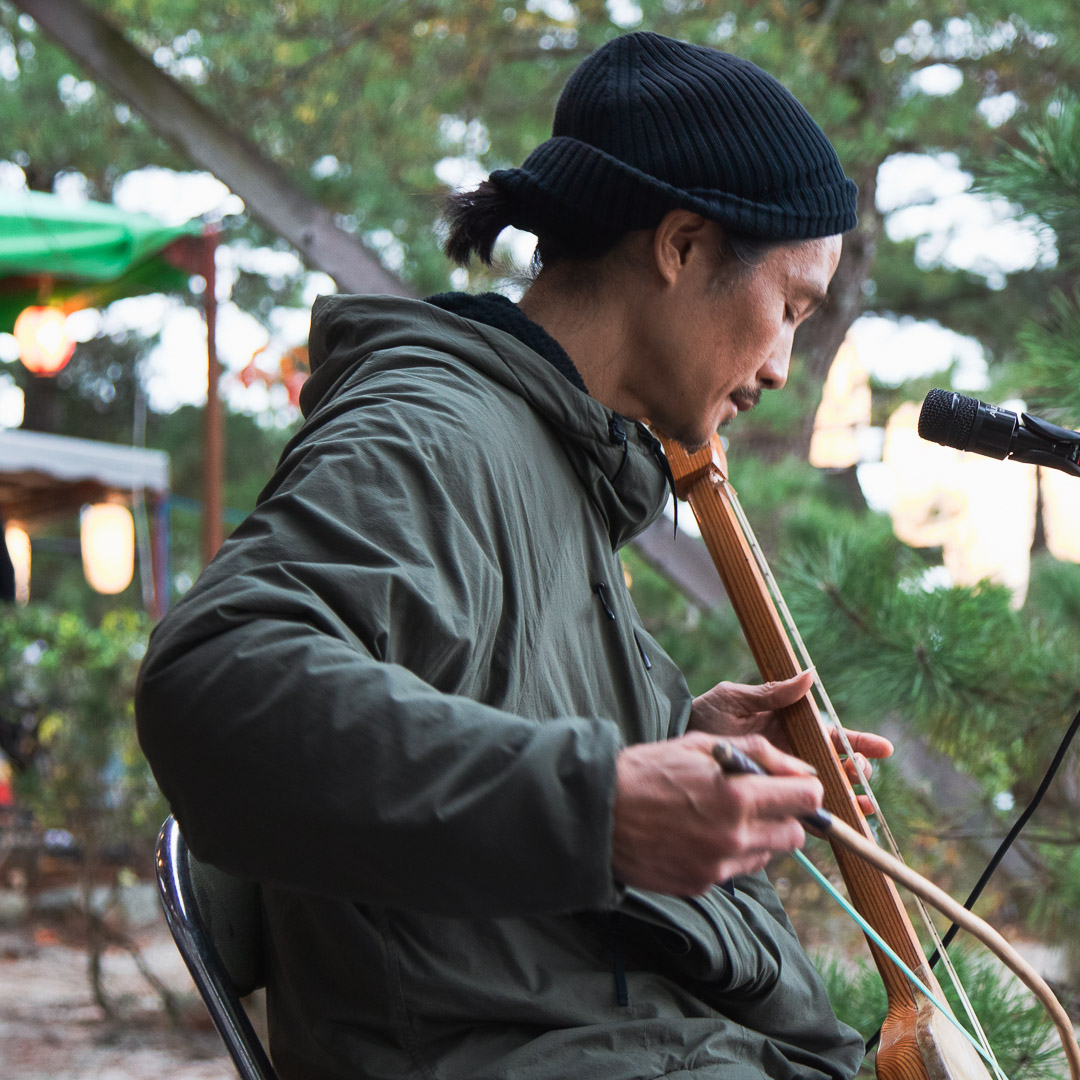
Born in Tokyo in 1979, Takaya Sasa has traveled through more than 60 countries, learning from life on the road—whether through cooking, music, shoemaking, or other crafts.
In 2013, he relocated to the banks of the Shimanto River in Kochi Prefecture, Japan, where he began building a lifestyle rooted in the land.
In 2016, he published The Salad Book (ささたくや サラダの本), a collection of raw food recipes and travel essays. He began creating pastel artwork in the summer of 2020, and in 2023, he self-published two books: TABI no Ohanashi-kai, a collection of travel stories, and Kurashi no Kage, a visual diary of daily life along the Shimanto.







